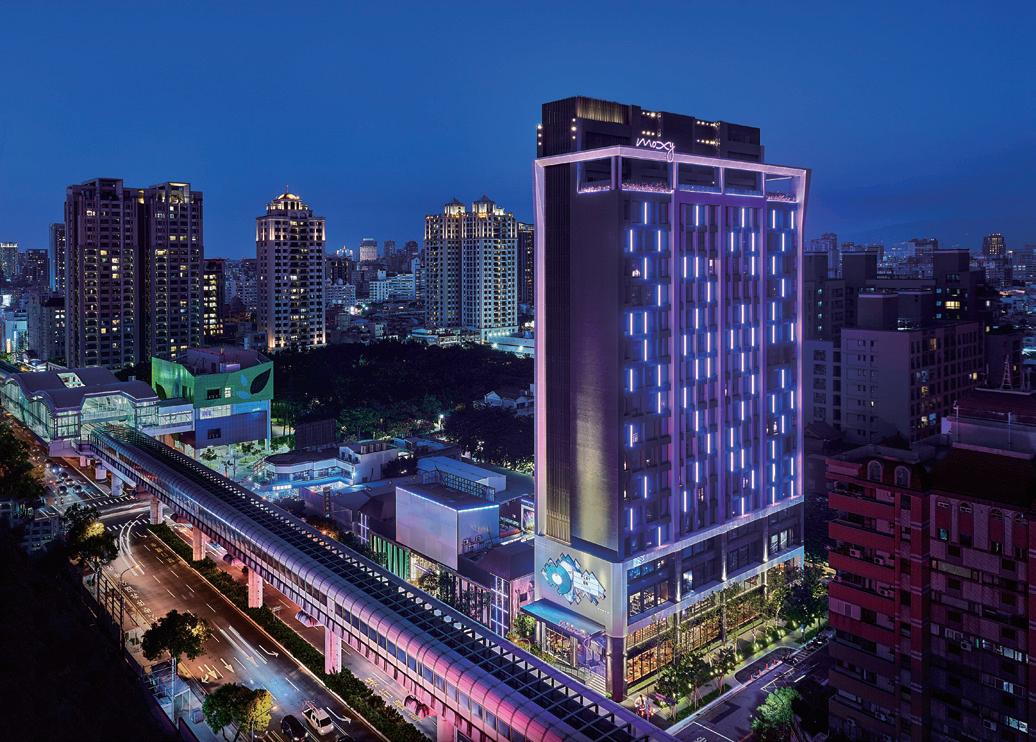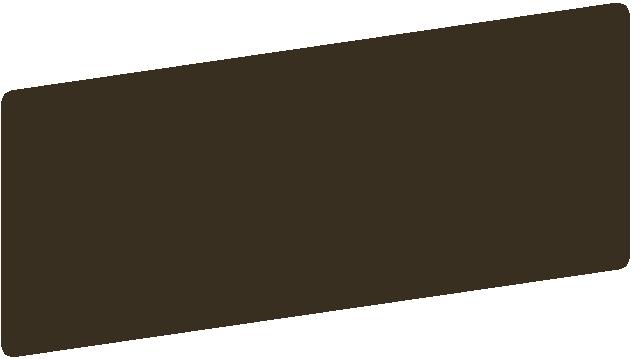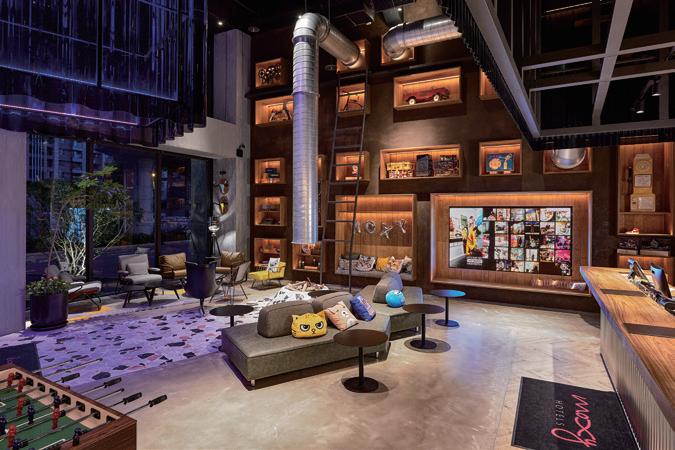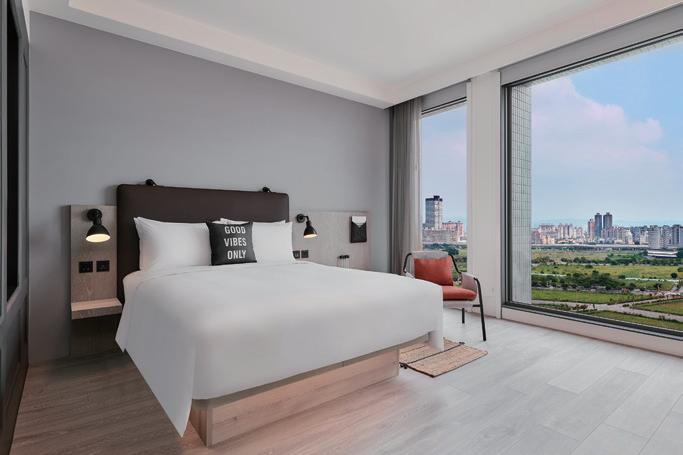Tea Country Nantou
Nostalgia in Taichung

Hiking in the Dakeng Scenic Area














Tea Country Nantou
Nostalgia in Taichung

Hiking in the Dakeng Scenic Area

















Spring has arrived, and the sun is covering the land with warming waves of sunshine. In this issue we bring you on cheery – and mostly outdoors – explorations of different Taiwan worlds: the world of tea, of urban heritage and nostalgia, of urban-area hill hiking, of traditional pastries, and of the beloved hard-working water buffalo.
In our main showcase article we’re taking you “flying away to mountains of tea” in Nantou, Taiwan’s only landlocked county. The various plantation areas introduced are all easy day-trips from the downtown area of Taichung City, just off the central-west coast. Among the many experiences there, you’ll be taking in spectacular mountaintop views and heading out into the fields yourself for guided DIY tea picking.
We deep-dive the Taichung urban core in two other showcase articles, their foci nostalgia touring and easy-access central mountains foothill trails. Attractions visited in the first are “old spaces made new tourist places.” The main stars are renovated heritage buildings from the Japanese colonial era (1895~1945) now housing a literature museum, restaurants and cafés, and a “six arts” (traditional Japanese martial arts) cultural center. In the second it’s a day spent in the exceedingly popular Dakeng Scenic Area in the foothills off the city center’s northeast side, which offers a web of firstrate trails from easy to mildly challenging. This area is also home to another unique nature-world gem, the Uncle Guo Macaque Farm.
Since we’re doing so much excursioning in central Taichung and nearby areas, it’s only natural that the accommodations highlighted in our regular Local Stay file are in the city’s heart. We concentrate on newer hotels targeting hipster travelers, and also intro tourist sites conveniently accessed by the Taichung Metro.
Your foray into the world of Taiwanese pastries comes in our Good Food department, your palate adventures enjoyed in selected traditional bakeries in the capital, Taipei, run by “families of bakers that have honed their craft over generations.”
We bring you back again to the land in a wholly different way with an Expert Talk day at Niutousi Farm in the island’s farm-rich Yilan County on the northeast coast. This leisure operation is dedicated to providing a comfy home for water buffalo now beyond their working years – a beloved animal iconic in traditional Taiwan rural life.
The worlds of the Taiwan spring are yours to discover!

Travel in Taiwan
The Official Bimonthly English Magazine of the Taiwan Tourism Bureau (Advertisement)
MARCH/APRIL, 2023
Tourism Bureau, MOTC
First published Jan./Feb. 2004
ISSN: 18177964 GPN: 2009305475
Price: NT$200
中華郵政台北雜字第1286號執照登記為雜誌交寄
Copyright @ 2023 Tourism Bureau. All rights reserved. Reproduction in any form without written permission is prohibited.
PUBLISHER
EDITING CONSULTANT
PUBLISHING ORGANIZATION
CONTACT PRODUCER
ADDRESS E-MAIL
GENERAL MANAGER
EDITOR IN CHIEF
ENGLISH EDITOR
DIRECTOR OF PLANNING & EDITING DEPT
MANAGING EDITOR
EDITORS
CONTRIBUTORS
PHOTOGRAPHERS
DESIGNERS
ADMINISTRATIVE DEPT
Taiwan Tourism Bureau
T. C. Chou
TAIWAN TOURISM BUREAU, MINISTRY OF TRANSPORTATION AND COMMUNICATIONS
International Division, Taiwan Tourism Bureau
Add: 9F, 290 Zhongxiao E. Rd., Sec. 4, Taipei City, 10694, TAIWAN
Tel: 886-2-2349-1500 Fax: 886-2-2771-7036
E-mail: tbroc@tbroc.gov.tw


Website: http://taiwan.net.tw
Vision Creative Marketing & Media Co.
1F, No. 5, Aly. 20, Ln. 265, Sec. 4, Xinyi Rd., Taipei City 10681, Taiwan
Tel: 886-2-2325-2323 Fax: 886-2-2701-5531 editor@v-media.com.tw
David Hu
Johannes Twellmann
Rick Charette
Joe Lee
Anna Li
Masako Takada, Sophia Su
Rick Charette, Ami Barnes
Chen Cheng-kuo, Ray Chang
Ian Tsai , Hsieh Yun-jhen
Lily Wan, Hui-chun Tsai, Xiou Mieng Jiang
This magazine is printed on FSC TM COC certified paper. Any product with the FSC TM logo on it comes from a forest that has been responsibly maintained and harvested in a sustainable manner.
This magazine was printed with soy ink. Soy ink is said to be more environmentally friendly than petroleum-based ink and to make it easier to recycle paper.
MAGAZINE IS SOLD AT:
1. Wu-Nan Culture Plaza, No. 6, Zhongshan Rd., Central Dist., Taichung City 40043 886-4-2226-0330 http://www.wunanbooks.com.tw/
2. National Bookstore, 1F., No. 209, Songjiang Rd., Zhongshan Dist., Taipei City 10485 886-2-2518-0207 http://www.govbooks.com.tw/
WHERE YOU CAN PICK UP A COPY OF TRAVEL IN TAIWAN
ABROAD
Offices of the Taiwan Tourism Bureau in Beijing, Shanghai, Hong Kong, Singapore, Thailand, Vietnam, Kuala Lumpur, Seoul, San Francisco, New York, Los Angeles, Frankfurt, and London. Taiwan Representative Offices; Overseas Offices of the Ministry of Economic Affairs; Overseas Offices of the Central News Agency; EVA Air, and other selected international airways; selected travel agencies in Asia, North America, and Europe; and other organizations.
IN TAIWAN
Tourism Bureau Visitor Center; Tourism Bureau; Taiwan Visitors Association; foreign representative offices in Taiwan; Tourism Bureau service counters at Taiwan Taoyuan Int’l Airport and Kaohsiung Int’l Airport; major tourist hotels; Taipei World Trade Center; VIP lounges of international airlines; major tourist spots in Taipei; visitor centers of cities and counties around Taiwan; offices of national scenic area administrations; public libraries
ONLINE
Read Travel in Taiwan online at www.travelintaiwan.net Find back issues (PDF version) on the publication platform issuu at issuu.com/travelintaiwan
Website issuu (PDF)
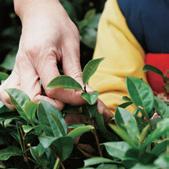
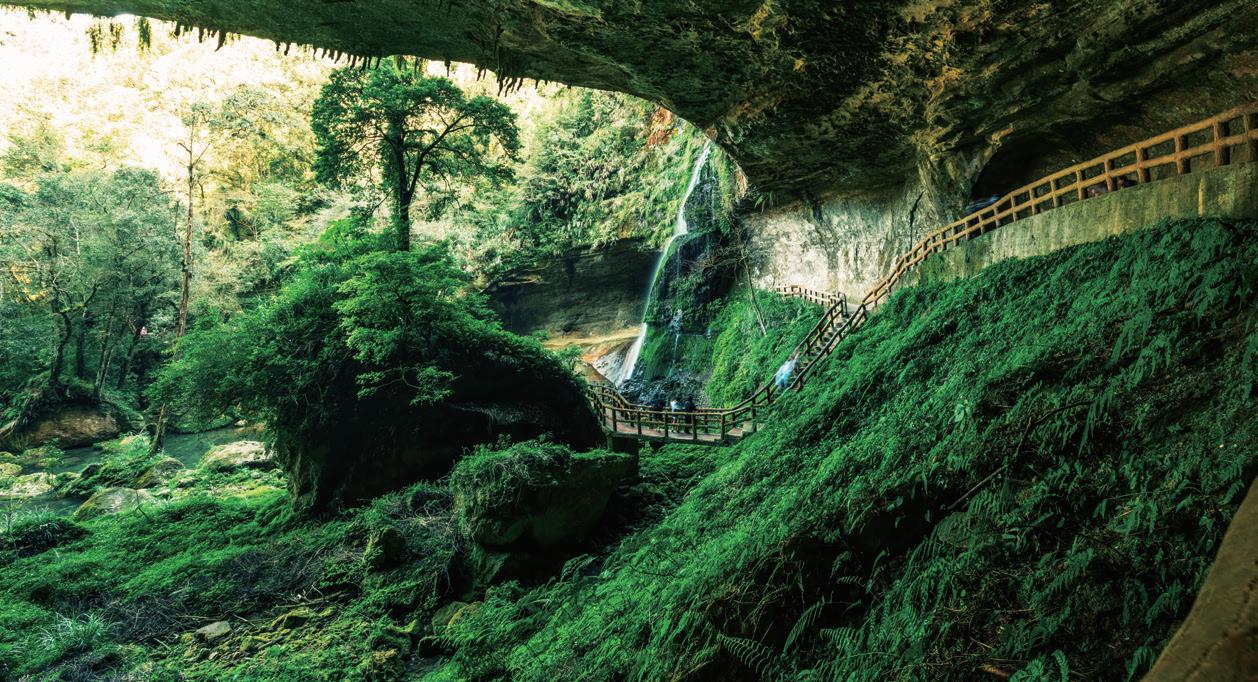
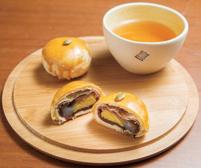
3 APRIL~MAY
Yilan County, situated in the northeast corner of Taiwan, is known for its agriculture – mostly on the triangular-shaped Lanyang Plain. It’s the perfect location for an exposition that highlights green tourism and protection of the natural environment. This expo presents an abundance of information on leading a green lifestyle, as well as cultural/artistic performances and horticultural displays. The event promotes environmental education and awareness of local industries, such as agriculture, fisheries, and tourism.
2023.yilangreenexpo.campaign.tw (2023 Yilan Green Expo)
APRIL 20~JUNE 29
The Taiwan International Festival of Arts (TIFA) is Taiwan's most important annual arts festival. A leading cultural event in Asia, it's jointly held at the National Theater and Concert Hall in Taipei, the National Taichung Theater in Taichung, and the National Kaohsiung Center for the Arts (Weiwuying) in Kaohsiung. This year there are a total of 129 riveting performances, featuring talent from France, Germany, Switzerland, Spain, Portugal, the United States, Canada, Israel, Singapore, South Korea, and Taiwan. npac-ntch.org/programs/series/tifa/ (National Performing Arts Center)
The Hakka people of Taiwan, a Han Chinese minority group that immigrated to the island starting in the early 17th century and often settled in hilly regions, especially those of northwest Taiwan, planted a large number of tung trees for commercial purposes during the Japanese colonial era (1895~1945). Today, the trees grow in the wild and, to the delight of hikers, bloom profusively in April and May, their snow-white blossoms covering tree branches and carpeting hiking trails. During the tung blossom season, numerous cultural events are held in celebration by Hakka communities in locations close to the forests. www.hakka.gov.tw (Hakka Affairs Council)
This fireworks festival is a key event attracting tourists to the islands of Penghu during the earlysummer season. Staged each year since 2003, it features well-known Taiwan singers and bands performing on the venue’s stage. The amazing fireworks displays, romantic music, and sea of lanterns combine to create resplendent scenes at Magong City’s Guanyinting Recreation Area.
www.penghu-nsa.gov.tw
(Penghu National Scenic Area)

This show has been held annually since 2005 at the Taiwan Orchid Biotechnology Park in Tainan City's Houbi District. It's a featured event on the international flower show calendar, along with the Japan Grand Prix International Orchid and Flower Show and the World Orchid Conference. Attracting thousands of visitors each year, the show is an important part of efforts to promote Taiwan's orchid industry. It features beautiful orchid displays and interesting arrangements and also incorporates cultural aspects and new biotech applications.
ios.tw (Taiwan International Orchid Show)
During this festival a variety of water-related activities and events are organized in Pingtung County’s Dapeng Bay area, including a sailing competition on the waters of the bay. Other fun activities involve canoeing, dragon-boat racing, stand-up paddling (SUP), jet skiing, and yachting. The event also features exhibitions promoting local industries such as agriculture, food, and tourism.
www.dbnsa.gov.tw (Dapeng Bay National Scenic Area)








Every season is travel season in Taiwan! Now that foreign tourists are streaming in again, there is a lot going on in the local tourism industry, including the opening of new hotels, museums, and a wide range of other tourist attractions.
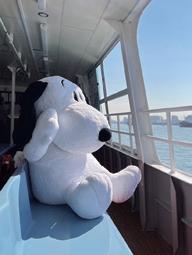
A new ferry service in Kaohsiung Port is now operating: Gushan Fish Market to Kaohsiung Port Warehouse No. 2 (KW2) to Qijin Island, and back again. The ferry, sporting cute Snoopy imagery, will be in operation until August 20, 2023. Tickets are priced NT$80 per trip, and there are four services on weekdays, each hour between 1pm and 4pm (seven on weekends and holidays, 1pm-7pm). bit.ly/3GUGPSX (Chinese)


The words “navy destroyer” and “cute” are rarely, if ever, mentioned in the same sentence, but in Tainan one decommissioned warship has recently been “cutified.” Shaun the Sheep, from the British stop-motion TV series of the same name, and his buddies are “throwing a party” on the navy vessel that now serves as the Navy Destroyer Museum. The endearing cartoon characters have instantly become favorites with selfie takers, and have significantly lowered the average age of the museum’s visitors.
www.teyang925.com.tw (Navy Destroyer Museum, Chinese)
The town of Yingge in New Taipei City is best-known as Taiwan’s center for ceramics. Its top attractions are the Old Street area – home to numerous ceramics shops – and the Yingge Ceramics Museum. Soon to join these tourist draws (official opening slated for April) is the New Taipei City Art Museum, located between the elevated tracks of the Sanying MRT Line, currently being constructed, and the Sanying Art Village Park. ntcart.museum (New Taipei City Art Museum)

1. Episode Hsinchu | 新竹伊普索酒店
Opened in November 2022; Hyatt Group hotel with 140 guestrooms; located in Hsinchu City’s East District www.hotelepisode.com/hsinchu

2. Chu Resort | 丘丘.森旅

Soft opening October 2022; located in Hualien County’s Fenglin Township churesort.com
3. Hotel Indigo Alishan | 阿里山英迪格酒店

Soft opening December 2022; located on Prov. Hwy 18, the main road through Alishan National Scenic Area www.facebook.com/HotelIndigoAlishan
Located in the Zhongzheng Arts and Cultural Business District in Taoyuan, the new main building of this city’s public library system impresses with a striking design. The 8-story building was constructed around a “Tree of Life” concept. Its most prominent feature is the “Eco Tube,” a cone-shaped multi-story metal/glass structure at the heart of the building.

www.typl.gov.tw (Taoyuan Public Library)

Taipei’s Ximending district has been one of the city’s most popular shopping and entertainment areas for many decades. Also home to a large number of smaller hotels, it is one of the capital’s tourist hotspots. With these visitors in mind, a new four-story visitor center has been designed by the city (opening in March), located right in the heart of the district, at 45 Hangzhou Street.
www.travel.taipei (Taipei Travel)

Since the coastal areas of southwest Taiwan are rather flat and sun-drenched hot, it takes some convincing to attract visitors to these parts of the island. Introducing tourists to the fascinating history of salt production has been one successful approach, and now a new art installation (completion date set for June) is bound to draw even more attention to this facet of traditional life along Tainan City’s coast. The large artwork, named “Life Tree,” is being erected at the old salt fields just to the north of Qingkunshen Qingshan Fishing Harbor, the shape resembling these fan-shaped salt fields.
www.twtainan.net (Travel Tainan)
PORTENT
天中殺
March 17~19 National Kaohsiung Center for the Arts ( Weiwuying ) ( Kaohsiung City )
April 28~30 Taipei Performing Arts Center ( Taipei City )
Portent is a contemporary opera based on jazz music that also incorporates chamber music, vocals, and freestyle saxophone play. A creation by playwright and director Hung Hung, in cooperation with composer Li Yuanchen and jazz musician Hsieh Minyen, the opera allows the performers to explore new possibilities for artistic creation through the combination of different genres and styles. The plot is based on a short story by Taiwanese writer Huang Ling-zhi (1928~2016) depicting the hardship of the common people in post-war times. www.tpac-taipei.org
LUMIÈRE: THE ENLIGHTENMENT AND SELF-AWAKENING OF TAIWANESE CULTURE

光─臺灣文化的啟蒙與自覺
Until April 24
Museum of National Taipei University of Education ( Taipei City )
This exhibition presents works from the 1920s through 1940s, a time of cultural and political awakening in Taiwan during the last two decades of occupation by the Japanese. Behind the national self-determination and civil-rights movement of the time was the Taiwan Cultural Association, established in 1921. The political movement went hand in hand with cultural innovation, with new artistic concepts flourishing in paintings, sculptures, novels, plays, and films. This exhibition attempts to traverse the aesthetic styles of the works and tell the personal journeys of artists from that period as it explores the specificities of the era and the ways in which artists gathered strength from within. montue.ntue.edu.tw
MINDSET•MATERIALS•MEDITATION: HWANG BUH-CHING

惟•物•觀:黃步青
Until April 9 Kaohsiung Museum of Fine Arts ( Kaohsiung City )
Taiwanese artist Hwang Buh-ching, born in 1947, is a pioneer of using mixed media for artistic expression. This exhibition presents a collection of his works across different periods of his career, starting with sketches, paintings, and works he created in his earlier days using mixed media such as newspaper, wood, and found objects to works created in recent years mainly using steel and disposed objects. One of his most representative works, Feast in the Wild, which was shown during the 48th Venice Biennale in 1999, is included in this exhibition.

2023 HENGSHAN CALLIGRAPHY
BIENNIAL: ERA OF PRINCIPLE AND NO PRINCIPLE INTERWOVEN— CALLIGRAPHY AS A VISUAL FORM 2023橫山書藝雙年展:法與無法交織的年代─書法作為 一種視覺形式
Until April 24 Hengshan Calligraphy Art Center ( Taoyuan City)

Opened in 2021, the Hengshan Calligraphy Art Center is a branch of the Taoyuan Museum of Fine Arts and the perfect place for appreciating fine works of calligraphy. This exhibition, the first Hengshan Calligraphy Biennial held at the center, focuses on the influence and development of calligraphy in the context of contemporary art, seeking to invigorate the development of contemporary calligraphy. The show features works by 42 calligraphers from various countries, presenting multifaceted contemporary calligraphy from around the world in an attempt to explore the future of the art form. tmofa.tycg.gov.tw
薪傳
April 21~31 National Theater ( Taipei City )
May 5~7 National Taichung Theater ( Taichung City )
May 12~14 National Kaohsiung Center for the Arts ( Weiwuying ) ( Kaohsiung City )

Legacy was created by internationally renowned choreographer Lin Hwai-min in 1978 when Cloud Gate, Taiwan’s foremost moderndance company, was just five years old. It is an homage to the modern-era pioneers of Taiwan, who came across the Taiwan Strait to settle on the island in the 17th century. The work has been presented internationally with 174 performances around the world, and is widely acclaimed as a masterpiece of choreography. In celebration of Cloud Gate’s 50 th anniversary this year, Legacy has been revived.
www.cloudgate.org.tw
2023 NTT ARTS NOVA

2023 NTT藝想春天
March 10~June 4
National Taichung Theater ( Taichung City )
National Taichung Theater’s annual NTT Arts NOVA is a series of performances in spring with a focus on “New,” as in “a new start”, “a new happening,” “a new world” with new ideas, visions, and perspectives. The program features a wide variety of stage performances featuring talent from Taiwan and abroad, including contemporary theater, indigenous dance and music, modern dance, dance combined with technology, a multimedia solo performance about music in history, puppet theater, percussion music, and more.
www.npac-ntt.org/ArtsNova
Located northwest of Taiwan, the Matsu archipelago consists of 36 islands. It is known for its unique mix of military posts, natural beauty, and cultural heritage. Seen as Taiwan’s fortress at the northern end of the Taiwan Strait the islands also serve as an important migration stop for numerous species of birds. Matsu is home to nearly 14,000 people who speak both Mandarin Chinese as well as the Fuzhou dialect.
The winters in Matsu are often harsh, but nevertheless on the 12 th day of the Lunar New Year locals and visitors alike will flock to Beigan Island ( 北竿 ) to take part in the Baiming ( 擺暝 ; Baiman in Fuzhou dialect) ceremony. During Baiming offerings are made to the gods at night. This traditional practice has been passed down from generation to generation with worship rituals taking place at different temples for different gods each night. It is the most important event on the island’s cultural calendar and a time when people come together to celebrate with each other and with the gods.

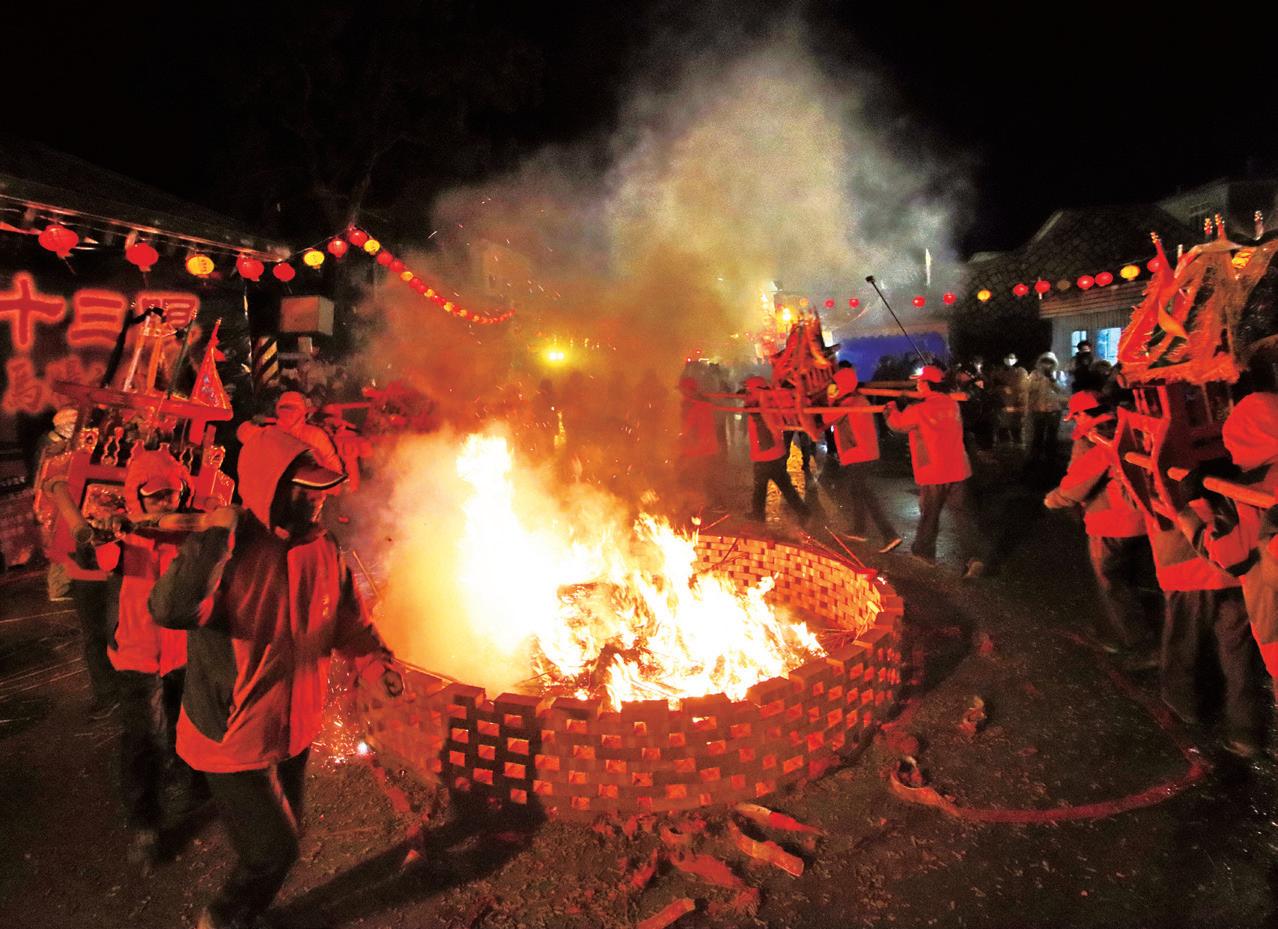
When you see colorful “wind lanterns” hung in doorways and hear locals, both young and old, dressed in traditional clothing playing drums and gongs, known as daguban, you know Baiming has started. Over several days, people carry offerings of food, incense, and flowers to local temples, and place them in front of the main alters to pay homage to gods and ancestors.
The Baiming ceremony is a highly choreographed event and also an opportunity for the people of Matsu to come together and socialize. The celebration sees no boundaries. People gather at temples, homes, and on the streets to eat, drink, and share hospitality and happiness.




Baiming reaches its peak when the palanquins, a symbol of the gods, are taken on processions around the island. On the 13th day of the Lunar calendar, people of Banli village for example have a procession where the palanquin for the God of the White Horse, a local deity, is carried to the temple of the God of Pingshui at Baisha, two kilometers away. Palanquins will meet each other along the way, and the mighty sound of the daguban will reverberate along the beaches of the island! On the return trip, households will burn hay as a way of thanking the god’s white horse and to ask for protection. Fireworks, burning flames, and the passion of the people make one forget about Matsu’s cold weather.
The Baiming ceremony is a testament to the resilience and rich cultural heritage of the people of Matsu. It is an event that should be experienced by anyone interested in the traditions and culture of Taiwan.
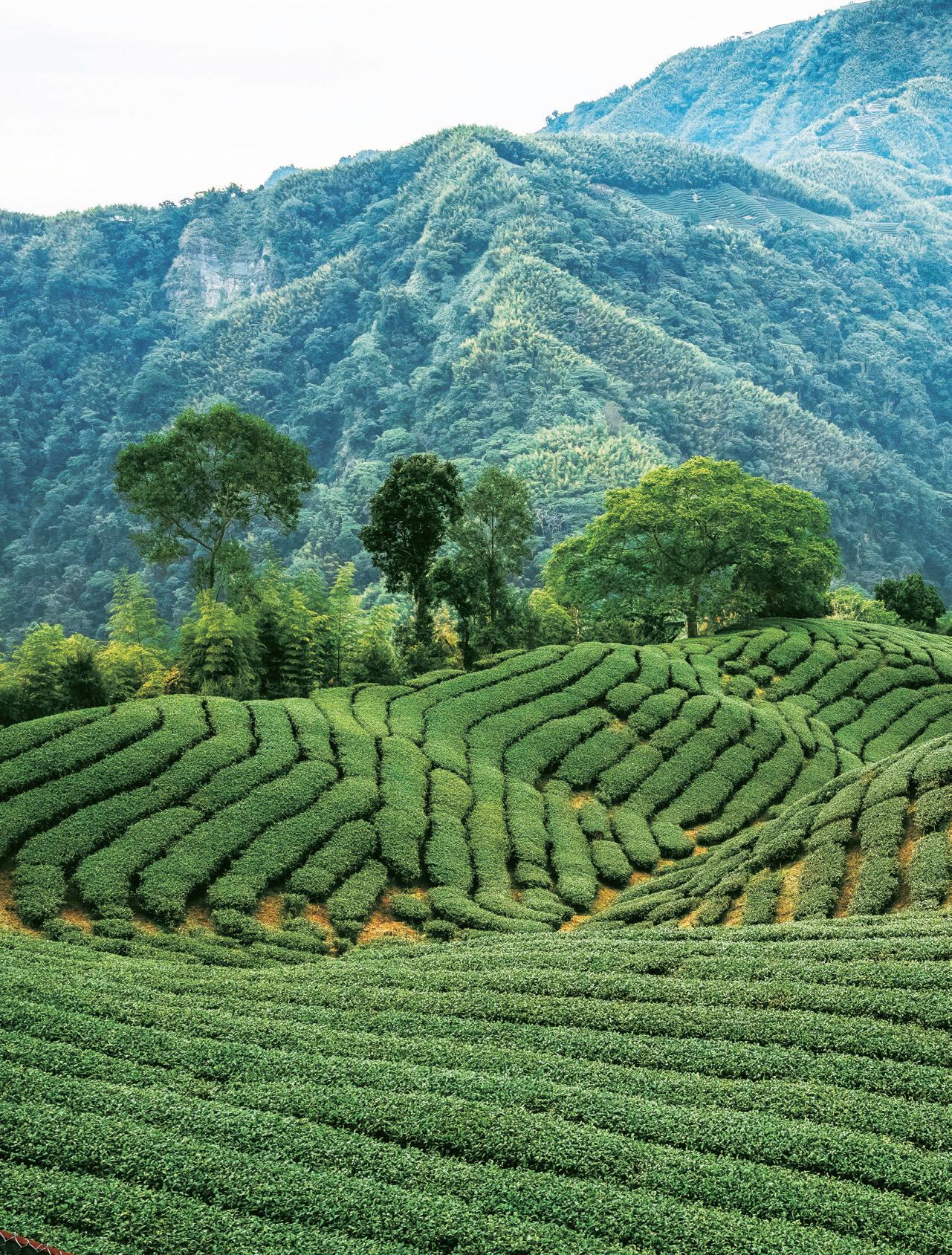
Is tea your thing? Invigorating mountain scenery? The simplicity and purity of countryside life? Long meandering drives along roads with few vehicles through farmland and forest? Well, we’ve got just the multiday trip for you, to tea country in the west region of Nantou County, moving between flatlands and mountains about 1,600 meters up.
In long, comparatively narrow Taiwan, Nantou is the only landlocked county. It’s entered by most via the long, narrow flatland strips on its western flank – at the edge of the western plains – leading up ever higher through foothills into central mountain fastnesses where surprisingly high numbers of permanent residents are found.
Nantou is primarily rural, just a few urban areas, with tea a key crop, grown on plantations in almost all of the county’s 12 townships. The climate is ideal for tea cultivation. Temperatures average 15~24 degrees Celsius, and dramatically varying terrain, elevations, and climatic conditions result in teas of unique character from each growing area.
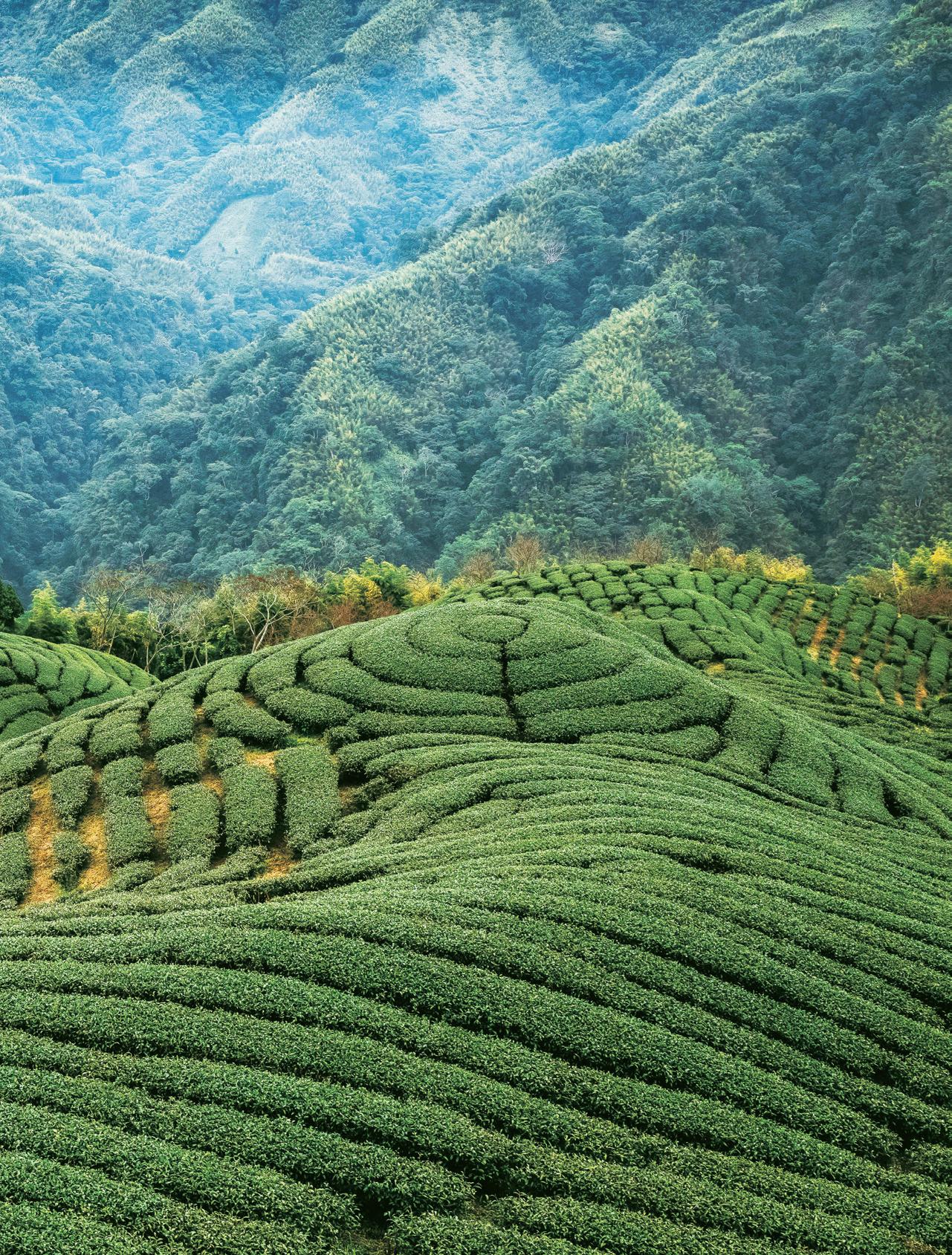
 TEXT RICK CHARETTE PHOTOS RAY CHANG, VISION
Bagua Tea Plantations in Zhushan Township
TEXT RICK CHARETTE PHOTOS RAY CHANG, VISION
Bagua Tea Plantations in Zhushan Township
This is perhaps the best-known of Nantou’s tea regions. Tea was first cultivated here in 1855, using bushes brought from the Wuyi Mountains in China’s Fujian Province. The ancestors of most Han Chinese in Taiwan emigrated from Fujian, directly across the Taiwan Strait during the Chinese imperial era; Fujian is a major tea-production region. In fact, the word “tea” is from Western traders’ attempts at the southern Fujianese for tea, pronounced “teh.”

This area is reached most easily via County Route 151, which starts in the flatlands town of Zhushan and takes you up past the tea-growing town of Lugu. Above Lugu, turn onto County Route 55, then a few hundred meters later (just past a small village), head steeply up-mountain on the winding plantation-access road, Yangwan Lane.
The tea plantations are spread out atop Dalunshan, or Dalun Mountain, from 1,250~1,500m above sea level. This is the biggest Oolong tea area in Lugu Township, measuring about 100 acres. You’ll also see thick swathes of gingko forest, planted in afforestation efforts to protect the steep slopes from erosion. The combination of tea-bush tiers of green, blue skies, intense golden-yellows of the gingko trees (in autumn), and the frequent fog and mist make for tremendous photos and videos.
Boardwalk paths and dirt paths take you through the tea-bush rows. At the highest point is a rest pavilion and, just below, a viewing deck. From these, tremendous views north are enjoyed, all the way to the long east-west valley through which the famed Jiji Line tourist trains run. Note that there is a trio of simple eateries in the plantation area, selling fresh range chicken and mountain vegetables.
Once a bamboo-cultivation center, local farmers began switching to tea starting in 1987, in the face of dwindling sales (bamboo wood was to that point widely used in scaffolding, furniture, etc.). Disease also hit the township’s bamboo in 1990.
Getting to Lugu's high-elevation tea plantations means driving on long and winding mountain roads. Once you are there, you will be rewarded with spectacular vistas


Reach this secluded forest resort area by taking County Route 151 to the popular Xitou Nature Education Area, then switching to the Shanlinxi Highway (County Route 95) just before the road’s terminus. An alternative is to continue past Dalunshan on Yangwan Lane, which connects with the Shanlinxi Highway.

Sun-Link-Sea is in a deep and narrow valley spread over an elevation of 1,600~1,880m. This is a privately operated getaway idyll (entry fee) where ecotourism is the clarion call. People come for three things – the abundant wildlife, the waterfalls, and the flowers. Anyone with moderate fitness can easily tackle all the spread-out sights walking, but a shuttlebus service is also available (fee).
At the valley’s upper end is Songlong Rock Waterfall, which hurtles over a wide semi-circular cliff, the waters gathering in a deep green-hue lagoon. A paved pathway leads behind the waterfall “into” the cliff’s base – a massive hollow 30m high and 30m deep – created by soft-sandstone erosion.
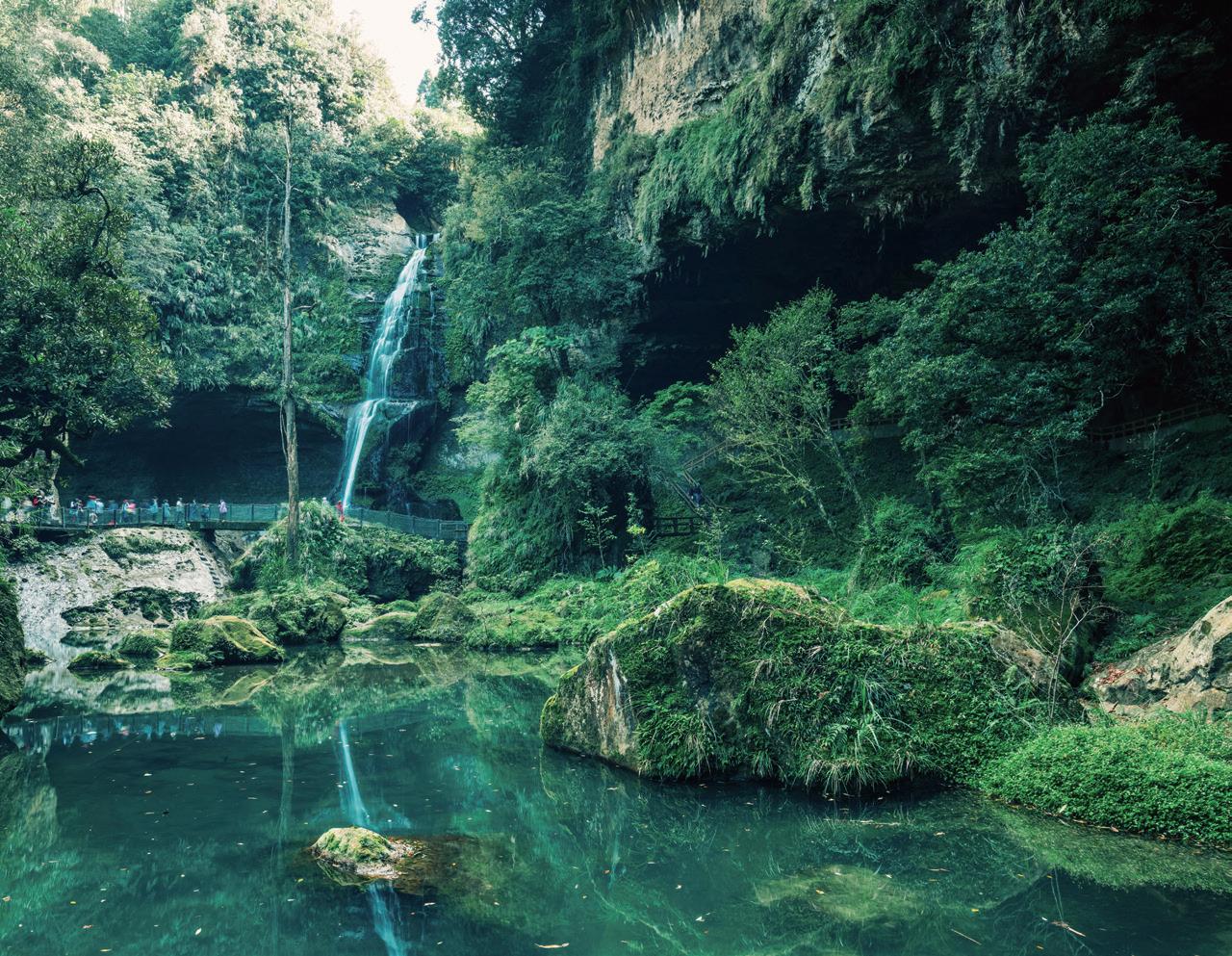
Toward the valley’s middle is the expansive Flower Center, laid out like a chateau’s gardens – showcase of a flower and medicinal-herb botanical research and teaching
center. The focus is on temperature-climate floral gems. Among the tourist-favorite residents are tulips, peonies, rhododendrons, Taiwan azaleas, hydrangeas, and golden bell flowers.
Lower in the valley is Shijing Ji, literally “Stone-Well Eddy,” a collection of ten stream-bed potholes, the deepest of which is 5.5m; the sightly 88 Suspension Bridge, which connects the easy-grade paved pathways that run along the valley-sculpting waterway; and the soaring 116m-high Qinglong Waterfall, this cataract and its gorge forming a superb “headward erosion” classroom.
The retail operation of Yen’s Tea Garden is right on County Route 151 as it runs through the town of Lugu. The Yen family’s farm is below the town, just off County Route 139. This family operation is today run by the third generation, a young couple who lived in the nearby city of Taichung for a time and decided to return and take over the reins in 2012 when the generation above began to experience health issues. Both are trained designers, a talent put to good use in the packaging, signage, and other elements of the business.
At the retail operation you’ll find a wide range of products, including Oolong loose leaf and tea bags, camellia oils, tea-infused perfumes, tea-based snacks, and traditional “Grandma”-style pillows with a filling of compressed tea stems. Cold-pressed oil extraction is used for the camellia seeds. Online shopping is also available on the sophisticated website the tea cultivator/designer team has set up, and shipping is also available.
Yen’s also offers a range of popular experience activities. Participants gather at the retail center, and are then led in
their vehicles to the family farm. For the guided Tea-Picking Experience, you don a traditional Taiwan conical farmer’s hat made with bamboo leaf and, carrying a cute tea-picker basket, head into the close-knit rows of tea to learn how to pick tea. At the end you sit down to fresh-brewed tea at a rustic table-and-chair set in the shade of the family’s adjacent fruit orchard to enjoy fresh-brewed Yen’s-leaf tea and snacks. The activity lasts an hour or so and costs NT$350 per person.
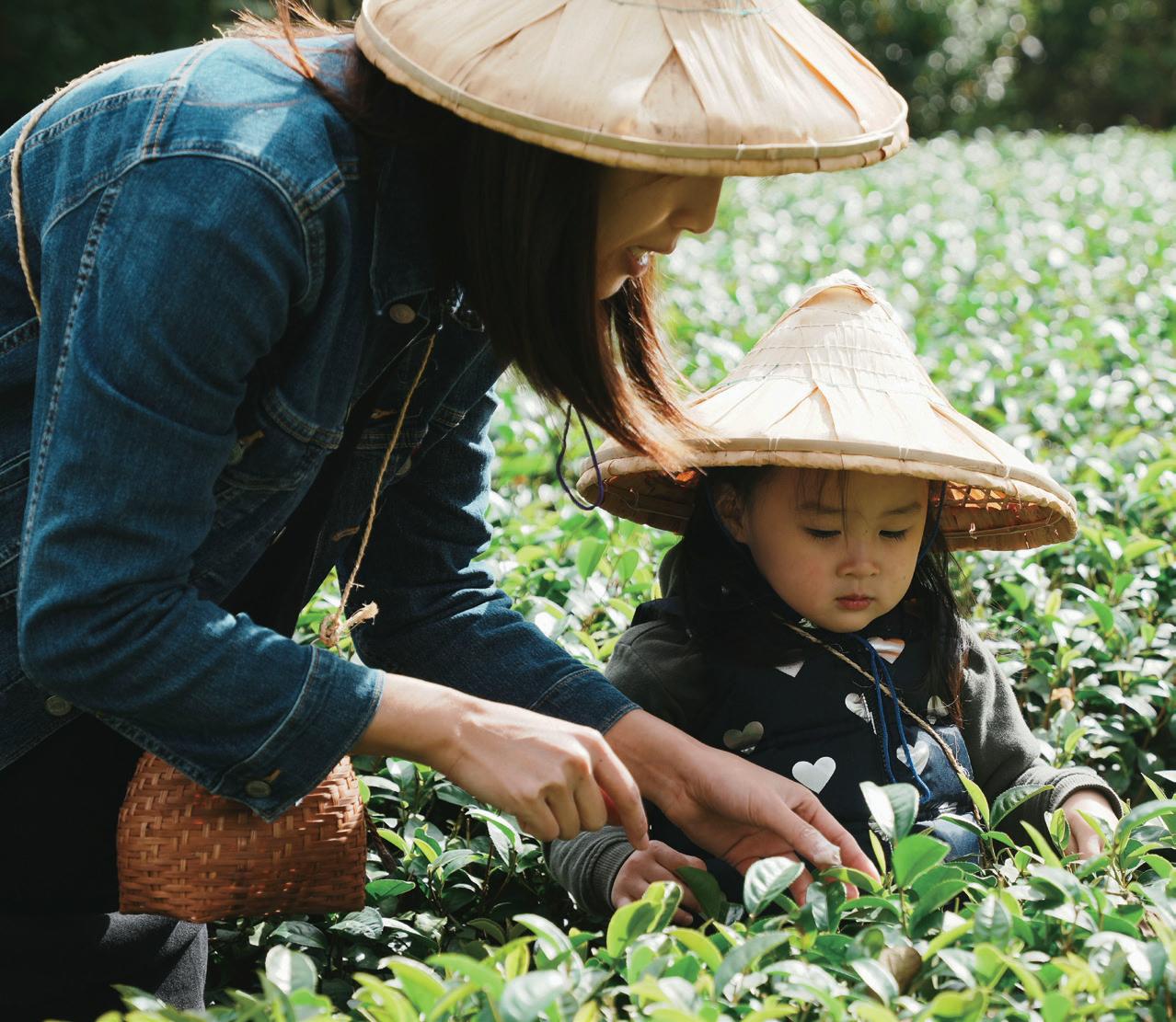
During the session you’ll learn of much beyond the details of how to recognize ready-to-pluck leaf and how to properly pluck without harming the bush. For example, how the Yen’s farm was affected by the aforementioned bamboo blight in 1990, causing a decision to concentrate on tea. How Yen’s tea bushes are thigh-high to enable easy manual plucking, whereas in nearby Songboling (to be visited later) they are low to the ground, with wider spaces between rows, to enable machine plucking; in the Yen family’s opinion, hand-plucking produces higher-quality leaf.

You’ll also learn how the name “Lugu” means “deer valley,” and how Taiwan’s western plains and foothills once teemed with deer, the herds eliminated during the Chinese imperial period for sale of their skins overseas, primarily to Japan (where they were put to such uses as leggings and quiver covers for samurai). How island tea consumption slid from the 1960s through 1980s, but then picked up dramatically after Taiwan’s population began celebrating the unique local homegrown culture and plantation areas were developed as tourist destinations. Today, most production is consumed in-country.
Among Yen’s other experience activities are DIY making of an afore-described traditional-style “Grandma” tea-scented pillow; a factory tour and DIY tea processing; forest tea tasting and tea-snack eating; and combo sessions.



The pillow-making activity lasts 1.5 hours and costs NT$650 per pillow. Participants are given one attractive Yen’s-designed box containing all necessary materials (compressed tea-stem bag, bright-design pillow-cover fabric, etc.). These boxes can also be purchased separately for at-home DIY use. The experience activity can either take place at the retail center or, for even more fun, at the farm in the shady fruit orchard. During the session your guide provides instructions and assistance and, yes, regales you with interesting Taiwan tea-culture nuggets of knowledge.
YEN'S TEA GARDEN ( 山中茶學 ) (04) 9275-0996
No. 336, Zhongzheng 1st Rd., Zhangya Village, Lugu Township, Nantou County ( 南投縣鹿谷鄉彰雅村中正一路 336 號 ) donglongtea.com (Chinese) www.facebook.com/donglongtea
Yen's Tea Garden tea-picking experienceThis township is in Nantou’s southwest corner. Tea and bamboo are two key crops here – “Zhushan” means “bamboo mountain.” Government authorities began encouraging local farmers to begin planting tea on a larger scale in the late 1970s. The township’s administrative center is the town of Zhushan, a flatlands urban agglomeration right at the base of the central-mountain foothills.
The main driving route to this area is County Route 49, with a switch and short drive along County Route 54 before another switch and short drive along Wuliao Lane. Note that County Route 49 terminates at a Shanlinxi Highway connection (see Sun-Link-Sea section above).
As with the Dalunshan plantations, the tea operations here are spread over a mountaintop like a tiered bush-row carpet (1,000~1300m altitude). The “Bagua” in the name refers to the bagua of Daoist cosmology, an octagonal trigram template with a series of short rows in a circle. In the middle of the
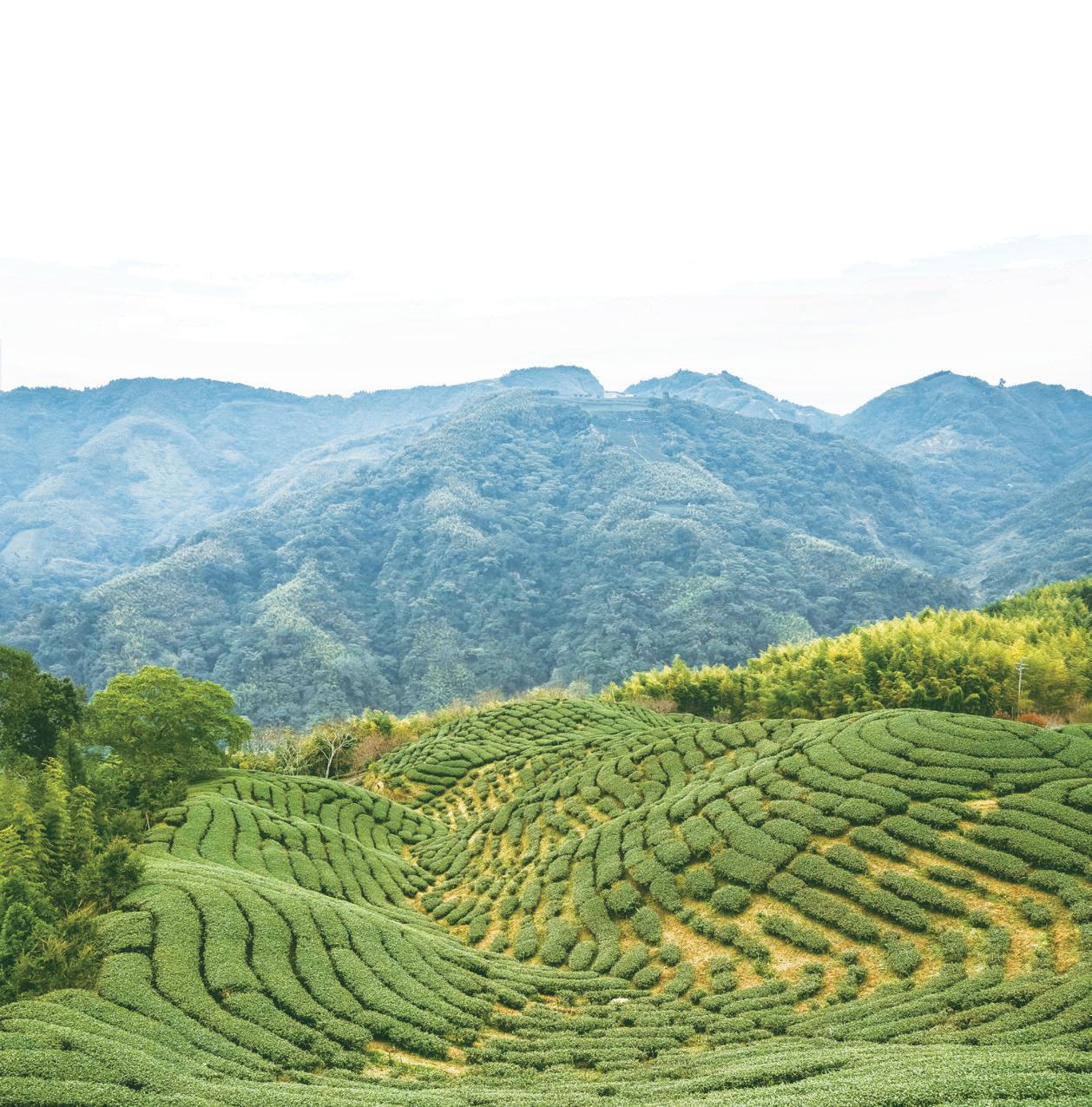
concentration of tea fields is a large mounded protuberance on which the tea-bush rows very closely resemble a bagua . Local farm folk say that most visitors believe this was created specifically as an auspicious symbol to attract good fortune, but in fact this pattern was incidentally chosen as the planting pattern most suited to the location’s slopes.
Unlike Dalunshan, where you park at the roadside or in the lot of any specific plantation’s retail center you are visiting, this area has a public parking lot. A stepped pathway just off the lot leads you up through a cherry-
tree tunnel, tea rows either side, to the Bagua Echo Pavilion, which has the area’s most panoramic views. There are higher peaks to the north, east, and south – the “big long” view is directly down a deep, narrow valley to the western plains. Twisting, most-often quiet Wuliao Lane also takes you to other area high points.
Directly across the lane from the parking lot is a large combo tea processing/retail facility with outdoor deck seating. Hot meals are served here, such as tea eggs and beef stew/chicken curry with rice.
Located in Zhushan town, this modern-look facility is housed in a once-abandoned factory, now completely transformed. The mission here is to provide visitors with an overview of the development of Taiwanese tea and an understanding of the production process and different types. The proprietor family has been engaged in the cultivation and processing of tea since 1880.

The specific retail-product focus here is Dong Ding Oolong, a celebrated varietal. Yoshan Tea uses traditional hand-plucking in its fields, averring that correct handplucking is essential to achieving a balance of a tea’s aroma and taste.
A variety of experience activities are offered. Each requires online booking through the official website or Facebook page. There is a free one-hour guided tour of the large Tea Culture House facility, providing edification on Taiwan’s tea history, tea culture, types, and processing. Another one-hour experience (fee) provides insight on the principles and differences between roasting and fermentation, and involves DIY tea kneading and roasting (take-home).
YOSHAN TEA
(04) 9264-3919
No. 19, Yanping Rd., Industrial Area, Zhushan Township, Nantou County ( 南投縣竹山鎮工業區延平路 19 號 )
www.yoshantea.com
www.facebook.com/yoshantea
A third one-hour experience (fee) is focused on proper tea-tasting methods to judge tea quality, with Taiwanese specialty teas front and center. All sessions are conducted in Chinese.
An extensive range of loose leaf and tea bag selections are available retail. Key are local-area Oolongs from Dong Ding (located in Lugu Township), with many other selections from around the island.

The Bagua Plateau, also called the Bagua Mountain Range, is a long north-south protuberance that sits on the western plains directly south of Taichung’s urban core, 32km long and 4~7km wide. Its highest point is just 424m above sea level. The western section of Mingjian Township is on the range’s southeast “foothills” slopes. This is home to the Songboling area, which tops the country in tea-leaf production, cultivating Oolong and Tieguanyin (Iron Goddess). County Route 139B runs north-south through this area.
This place is just southeast of small Songboling town, the area’s administrative center. One of the township’s most tourist-popular plantations, it features an unusually large retail center, informative tea-culture mini-museum, and family-friendly relaxation area with fine views looking west.

The first question all visitors ask: “What’s with the ‘Finger’ in the name?” At the entrance of the touristservice building (entry fee), you’ll see a meter-plushigh caricature of a bespectacled farmer, handkerchief around neck, with an upraised hand that’s short a few digits. This is the proprietor, who lost the digits to teaprocessing machinery but obviously did not lose his sense of humor. His family has been Songboling tea cultivators for over a century.
On entry you find yourself at the head of a winding corridor. First up is the mini-museum, presenting a variety of edifying displays. On the traditional teamaking process, using exquisite bronze statuary; on Tea
Two Fingers’ own teas, such as Aged Tea, Osmanthus Oolong Tea, and Longan Charcoal Tea (English for this one); on the world’s major tea-production areas, including Taiwan; and on Taiwan’s own major areas, with clear-plastic containers filled with leaf from each, smell-sampling encouraged.
The mini-museum corridor opens up to a gauntletlike winding aisle through the retail-area displays, offering a cornucopia of tea-purchase options and other area agri-products. Fresh-made tea drinks are also available, including pearl milk tea.

The rear outdoor recreation area is a tea garden with picnic tables, rest pavilions, a tall pearl milk tea sculpture, small tea-kettle cottage, petite aviary with very tourist-friendly exotic birds, two-story-high lookout tower, ice-cream stand, and small ramen restaurant.
(04) 9258-3126
No. 32-1, Puzhong Lane, Mingjian Township, Nantou County ( 南投縣名間鄉埔中巷 32 之 1 號 ) www.fingertea.com.tw www.facebook.com/fingertea/

This expansive center is in Songboling town’s south on Route 139B, which doubles as the town’s main thoroughfare. It fills up the main level of a large four-story building.
Just outside the entrance is a garden area in which the Tea Tree (melaleuca alternifolia), native to Australia/Southeast Asia, is on show. English signage explains how its aromatic-oil needle leaves have long been used to make Melaleuca/Tea Tree oil, used as an insect repellent, traditional herbal medicine, etc.

Stepping inside, directly before you is a sample of the exquisitely carved wooden latticework doors found at traditional countryside sanheyuan (three-sided courtyard houses). An antique-style low wooden table topped with the tea paraphernalia needed to welcome guests sits before it.
Among the most compelling of the other varied eduattractions: a large 3D topographical map of the Bagua Plateau region with tourist spots marked; a selection of traditional farm machinery and implements; a section on Songboling’s history and tea varieties; and a section on Taiwan’s scented teas and the fruits, flowers, and herbs used to make them. There is good and abundant English.

(04) 9258-0525
No. 181, Sec. 2, Mingsong Rd., Mingjian Township, Nantou County ( 南投縣名間鄉名松路二段 181 號 )
www.trimt-nsa.gov.tw

This township is at Nantou’s geographical heart, where foothills meet high mountains. At its heart is Sun Moon Lake, an iconic Taiwan tourist attraction offering visitors a splendid array of leisure, recreation, and accommodation pleasures. The main route here is National Highway 6 from Taichung City’s urban core, with a switch to Provincial Highway 21. Sun Moon Lake is also known for black-tea production. In the 1920s, the Japanese, Taiwan’s rulers from 1895~1945, introduced plants from India’s Assam region. Black tea became an important Taiwan export. As production costs rose in the 1960s-1970s, many fields were converted to Oolong or Pouchong, consumed domestically. Today about 400 hectares remain dedicated to black tea.
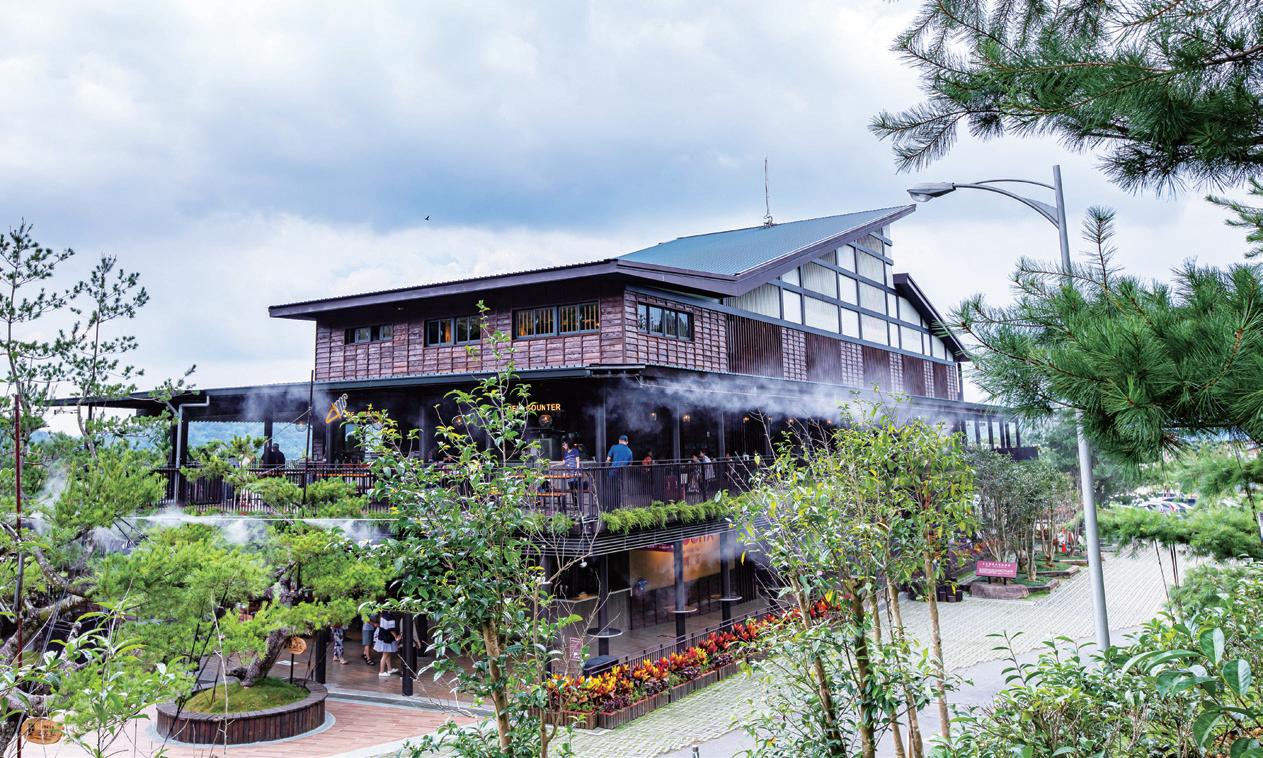
Hohocha is a large-scale attraction right beside Highway 21 just north of Sun Moon Lake. The theme here is black tea (Assam, Amber, Ruby, Amethyst varieties). Its diverse facilities sit amidst an expansive hillside/hilltop tea plantation. For the best visit experience, join one of the regular free guided tours (Chinese). These start at the main building, a three-story Japanese-style wood-built edifice that’s a combination exhibit/retail/dining facility. Your guide explains the tea-processing operations on the main floor and introduces the building’s different services. It’s then into the fields for an intro to the various leaf types and hilltop leaf-gathering facility.
In the main building’s 3F dining/DIY hall visitors enjoy a free tea-sampler tray and succulent Hohocha tea egg. Tea ceremony and DIY activities are held here: tea kneading, blending, sealing, etc. The 2F retail center has teas and a big array of teatheme snacks; a bakery provides oven-fresh tea cookies, biscuits, and other goodies. On a 2F balcony is a stand with seating at which house-made gelatos, sausages, and dried bean curd are sold, black tea used as a flavoring for the latter two and for numerous gelato selections. DIY tea-as-ingredient pizza sessions are also held here. 1F stands sell fresh-prepared tea eggs, tea luwei (soy-braised tasties), and tea drinks.

This attraction is also beside Highway 21 just north of the lake. The main cultivar sold at this plantation/factory/retail operation is Taiwan Tea No. 18. This is a black tea – the Sun Moon Lake area’s most popular – which is a cross-breed of Assam tea with a wild Taiwanese mountain tea that has hints of cinnamon and mint.
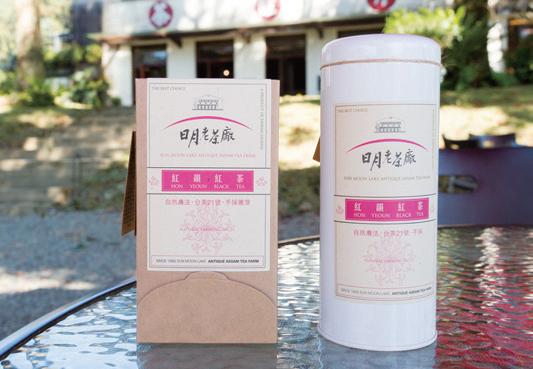
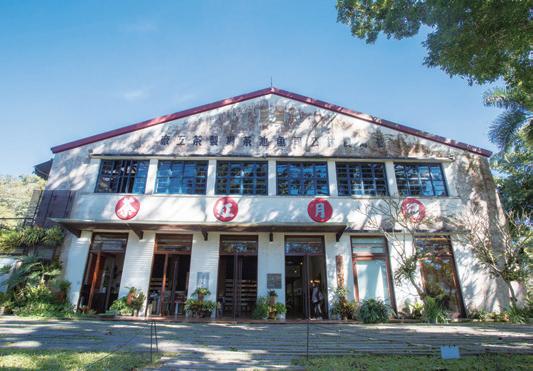
A wide range of loose leaf and tea bag choices is available in the retail center. Also
for sale is a tasty selection of food items, including black tea-flavored rice crackers, green tea candy, black tea date and walnut candy, green tea pumpkin seed crisps, camellia oil and sesame seed oil, “teadrinking” snacks such as dried fruits (green mango, mango, pineapple, guava, carambola), plus fruit vinegars and coffee beans/dripcoffee bags.
HOHOCHA ( 喝喝茶 )
(04) 9289-5899
No. 443-36, Yuchi St., Yuchi Village, Yuchi Township, Nantou County ( 南投縣魚池鄉魚池村魚池街 443-36 號 )
www.hohocha.com

www.facebook.com/sunmoonblacktea/
SUN MOON LAKE ANTIQUE ASSAM TEA FARM ( 日月老茶廠 ) (04) 9289-5508
No. 38, Youshui Lane, Zhongming Village, Yuchi Township, Nantou County ( 南投縣魚池鄉中明村有水巷 38 號 ) www.assamteafarm.com.tw www.facebook.com/sunmoonteafarm
ENGLISH AND CHINESE
88 Suspension Bridge 八八吊橋
Bagua Echo Pavilion 八卦回音亭
Bagua Mountain Range 八卦山脈
Bagua Plateau 八卦台地
Bagua Tea Plantations 八卦茶園
Dalunshan Tea Plantations 大崙山觀光茶園
Dong Ding Oolong 凍頂烏龍
Flower Center 花卉中心
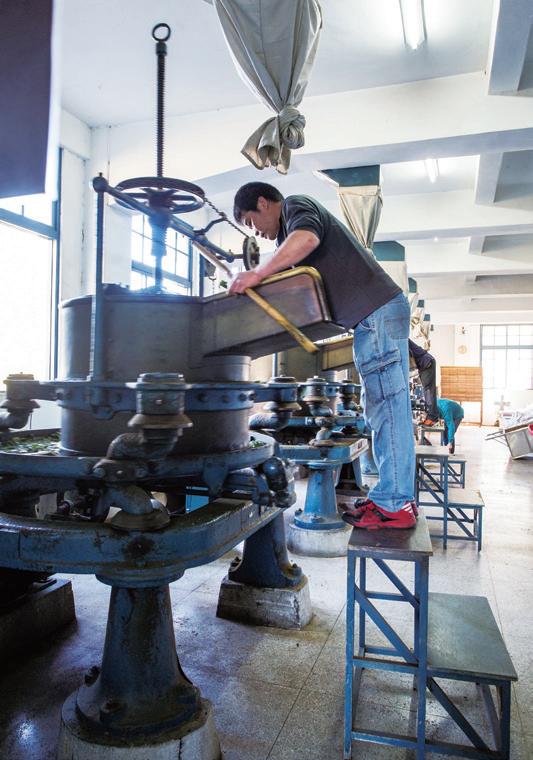
Jiji Line 集集線
Lugu Township 鹿谷鄉
luwei 滷味
Mingjian Township 名間鄉
Qinglong Waterfall 青龍瀑布
sanheyuan 三合院
Shanlinxi Highway 杉林溪公路
Shijing Ji 石井磯
Songlong Rock Waterfall 松瀧岩瀑布
Sun Moon Lake 日月潭
Wuliao Lane 五寮巷
Wuyi Mountains 武夷山脈
Xitou Nature Education Area 溪頭自然教育園區
Yangwan Lane 羊彎巷
Yuchi Township 魚池鄉
Zhushan Township 竹山鄉
Here’s a mini-parade of heritage places that have been given new life and that make for a great one- or two-day walkabout tour. All save the last entry are within the city’s older quarter, immediately west and north of Taichung Railway Station. For those who don’t fancy walking 15~20 minutes at a stretch, the public YouBike rentals are another great option.
The city of Taichung, founded in 1705, is in central Taiwan – “Taichung” literally means “Taiwan central.” The weather is famously balmy here, much drier than in the north. The high hills and mountains in the city’s north encourage arriving dark-cloud armadas to drop their liquid before reaching Taichung, and it’s far enough north to escape the south’s intense warmth. Its central core sits in a sea-level basin just off the western coast. The city has been on a tear the past two decades creating stylish new architecture and green spaces, but its smaller size, lower population density, and less-intensive economic development in comparison to comparative behemoths Taipei and Kaohsiung has meant the survival of a wonderful trove of heritage assets, more and more being renovated and given new tourist-attracting missions.
This is a tree-shaded compound of renovated classical-style Japanese wood buildings, tranquil and genteel, that is just steps from the color-zestful and raucously boisterous Taichung Fifth Market, providing you the most sensory-stimulating Taichung life & history contrast experience.


The Fifth Market, among the city’s most popular, dates to the 1960s, expanding from an existing base of pickling specialists. It boasts over 500 shops and stalls, selling hot foods, drinks, fresh produce, clothes, gift items, antiques, and more.
The museum’s structures date to 1932, built during the 1895~1945 Japanese colonial period. This was a Japanese police base – police station front and center, dorm and other facilities elsewhere. There are six single-story buildings, used for permanent exhibits, special themed exhibits, promotion of children’s literature, workshops and lectures, administration, and dining. A tremendous heritage-protected banyan today fills up a courtyard formed by three structures, looking out into the rear-area gardens, full walls of roots plunging from towering branches straight down into the ground. One of these buildings houses the quaint and cozy wood-theme NMU Café, serving coffees, tea drinks, cakes, cinnamon rolls, waffles, and paninis.
Since the Japanese era, Taichung has been a hub of literary activity, and during the Japanese and post-WWII periods was a stronghold for literary associations, many also involved in nativist political activity.
TEXT RICK CHARETTE PHOTOS RAY CHANG, VISION Taichung Literature MuseumThis complex was originally situated inside a large prison complex. Both were constructed during the Japanese era. The prison opened in 1903 (torn down in 1992), the buildings of today’s cultural center in 1937. This latter cluster was a dojo complex –a school for training in various Japanese arts of self-defense used by Japanese law-enforcement officials, with a clubhouse and dormitories also on-site. A fire in the mid-2000s destroyed the traditional Japanese-style wood buildings; some have been rebuilt.
The main hall, at the front of the complex, was used for kendo and judo. This is the only remaining well-preserved martialarts hall in Taichung. Kendo was practiced on the left, judo on the right, with a shrine in the rear middle. Kendo equipment can today be seen on display. Architecturally, the classical Japanese martial-arts model was used, featuring an elevated base with tamped-earth innards, hip-and-gable roof design, bargeboards, and large onigawara (Japanese gargoyles).
The center’s other buildings form a large courtyard behind the main hall, with a massive heritage-protected banyan born in 1895 in the middle and picnic tables for visitors to rest. The exquisitely reconstructed wood building to the main hall’s left today serves as a teahouse. A snack bar is in another building.

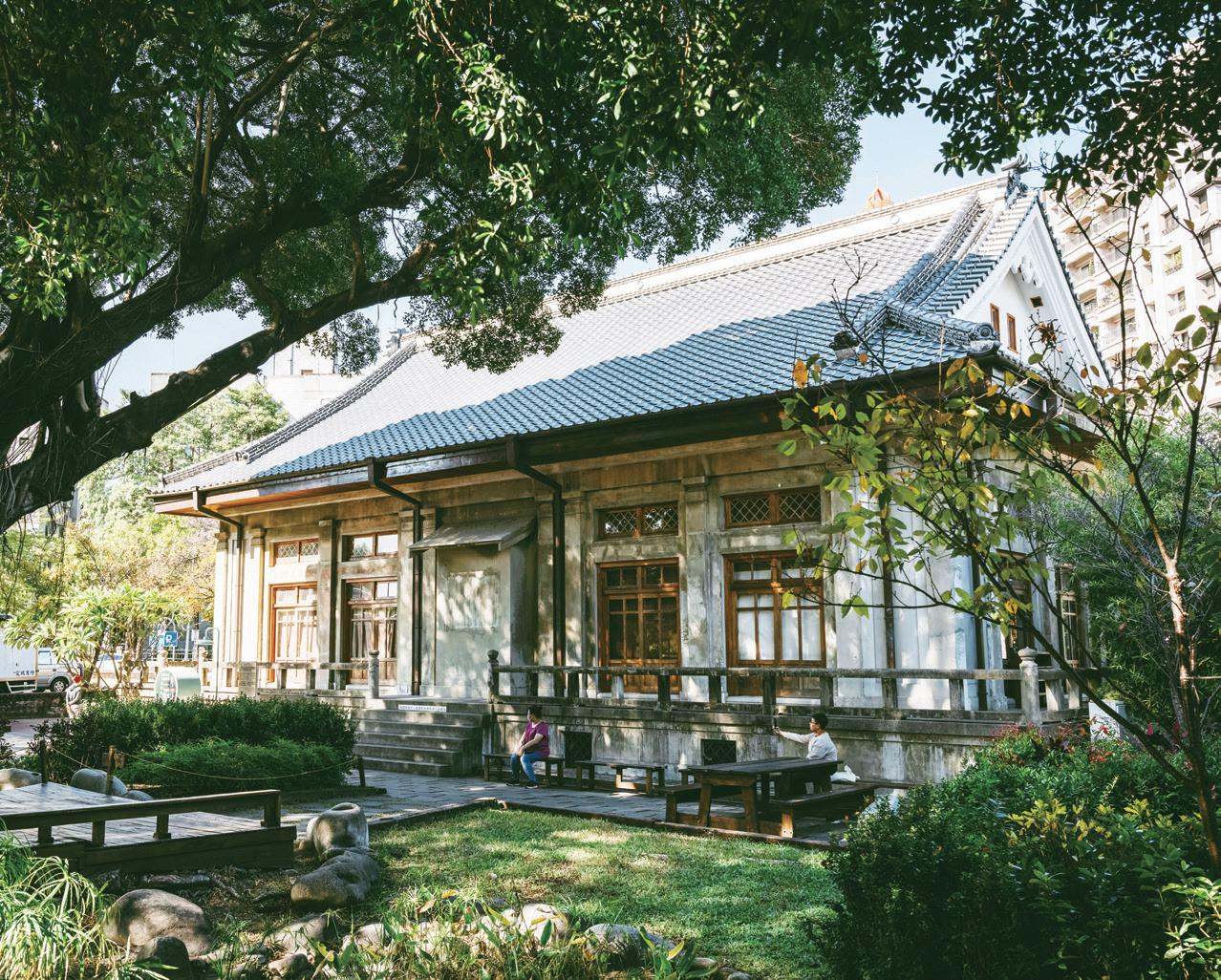


Bulao 125 is in a heritage-architecture site today officially called the Residence of Miyahara Takeo. This mansion complex was constructed in 1933 for the Japanese optometrist. After Japan’s 1945 WWII defeat, Taichung’s city government took over, converting it for use as the mayor’s residence. It was later put to city council use, as a guesthouse and then a staff dormitory.
The architecture consists of two conjoined buildings, one a single-story classical-style Japanese building of wood, the other a two-story French-style mansion. Miyahara Takeo had constructed a small private optometry hospital on the site in 1927, but tore it down and built the mansion complex in 1933, for three reasons: he decided to build a larger hospital facility elsewhere, his wife had arrived from Japan and he needed larger living quarters, and he needed more space for culturalassociation activities he was involved in.
In 2016 a local senior citizen welfare foundation was invited to revitalize the then-abandoned complex, and undertook a thorough renovation (a key problem was termite infestation). Today it operates the Bulao Eatery in the Japanese section. There is a Louisa Coffee chain outlet on the Western section’s first level, and an informative exhibit on the property’s history on the second, with a detailed timeline (in Chinese), period photos, and wall displays (with English) on the European section’s classicalstyle pillars, decorative railings, and sliding windows.
All Bulao Eatery staff are retired seniors given special training. There are mixed Chinese/Western light set meals, morning/afternoon tea with tiramisu and other treats, and much else.




BULAO 125 ( 不老夢想 125 號 ) (04) 2227-0125
No. 125, Sec. 1, Shuangshi Rd., North District, Taichung City ( 台中市北區雙十路一段 125 號 ) 7am~7pm www.bulao125.com www.facebook.com/bulao125
Old Japanese buildingThis restaurant/café is just one block from the Taichung Literature Museum, and also on the doorstep of the Fifth Market. And like the museum, the heritage Liuchuan (“Willow River”) Canal runs just to its north. This irrigation waterway, dating to the Japanese period, has been a popular attraction since mid-2010s dredging and improvements, with pleasant waterside walkways and many tree types planted, especially willows.

Jieyou Laozhai is in an old, compact renovated Japanese wood-and-brick residence built in the late 1930s. On the menu are Western-style brunches, light meals, waffles, desserts, and hot/cold beverages.



Many of the old elements have been retained, such as ceramic tiling, cypress-frame windows, terrazzo flooring, etc., and faithful retro-style elements such as stained wood-board flooring, tatami flooring, and Japanese-style sliding doors have been added. The space is also filled with vintage decorations, not all from the 1930s, such as old radios, clocks, suitcases, and musical instruments.


This venture is beside the Art Museum Parkway, a multi-block tree/grass green belt that runs between the National Taiwan Museum of Fine Arts and the Liuchuan Canal. All along the parkway are restaurants, cafés, boutiques, cultural-creative bookstores, art galleries, and other tourist draws.

Blank Plan is a concept experiment occupying an old four-story building that wraps around an intersection corner, completely redesigned inside and out. The design-team owner-operators have taken the four floors and made them, collectively, an immersive experience encompassing space, sensory experience, and fine artisticliving product-purchase selection. The levels are designed as spaces one enters with a “blank plan,” you as “blank slate” open to new uplifting life aesthetics.
The first level is designed as a “quiet green” tea-art experience space. It sports old weathered wooden tables, wooden chairs from old-time theaters, and mottled, irregular gray walls to convey the passage of time. The rounded service bar is low, same height as the tables, to encourage customer interaction with the tea masters.
The second level is a space of “day and night floating shadows.” By day baristas prepare hand-brewed fine coffees. By night bartenders concoct themed, personalized wine-experience sets.

The theme on the third level, a retail and teaching space, is “blue moonset.” The emphasis is on unique-style, sustainable aesthetic products by artists and indie designers. The Blue Beach section showcases long-lasting, tailor-made denim apparel. There’s also a fine-living exhibit/teaching space.


The fourth-level theme is “sunshine landing.” This is an “interpretation space” with periodically changing sensory-experience exhibits (entry fee).
BLANK PLAN ( 留白計畫 ) (04) 2375-5002
No. 45, Wuquan W. 4th St., West District, Taichung City ( 台中市西區五權西四街 45 號 ) 10am~6pm theblankplan.com (Chinese) www.facebook.com/blankplan.tw
Take-out counter Second-floor cafeSHENJI NEW VILLAGE ( 審計 368 新創聚落 )
(04) 2302-3138

No. 12, Alley 2, Lane 368, Minsheng Rd., West District, Taichung City ( 台中市西區民生路 368 巷 2 弄 12 號 ) 11am~8pm

www.facebook.com/shenji368 www.instagram.com/shenji.368
This is a small, dense neighborhood of renovated lightyellow concrete-and-brick buildings that dates to the 1960s. The structures were built as dormitory facilities for Taiwan Provincial Government personnel; this government level is now defunct. The main street is paved with pebblestone and red brick. Paved footpaths lead through the other areas. In numerous places new wooden staircases lift you up to second-story balconies and boardwalk-style pathways tickled by tree foliage.


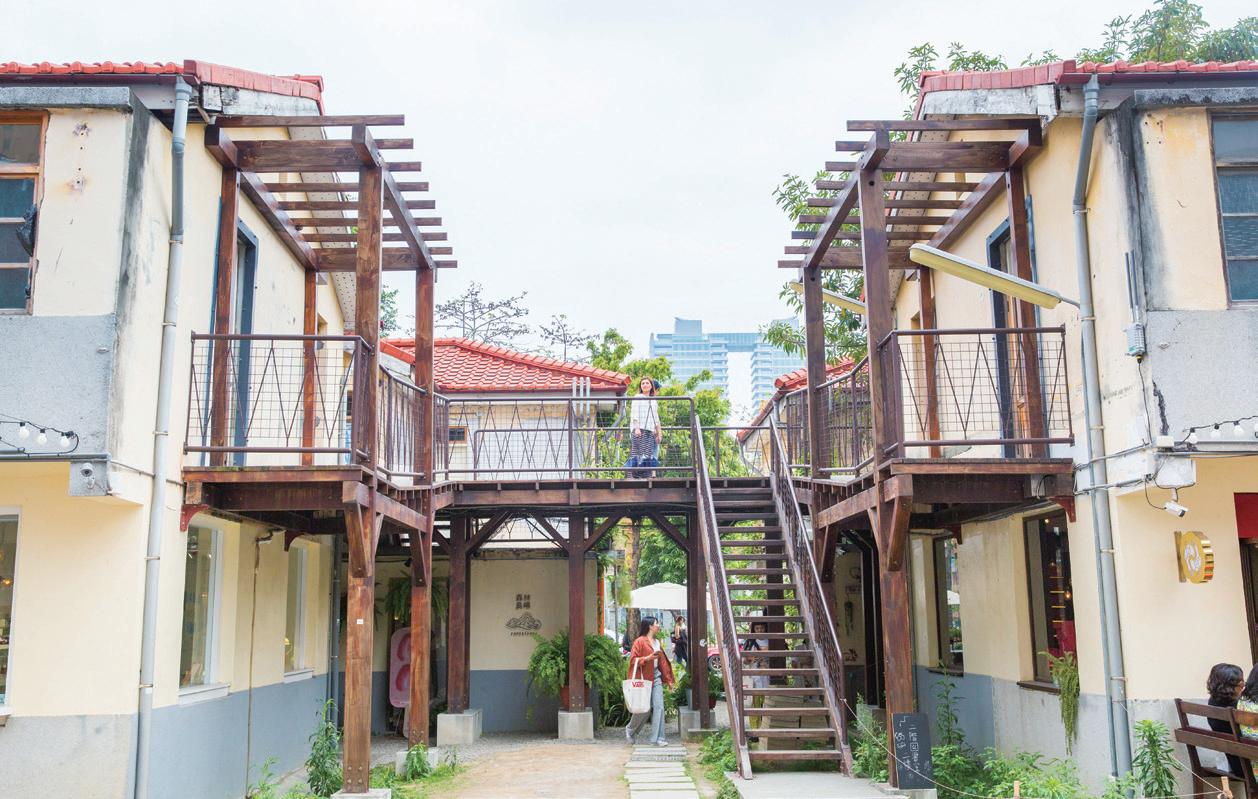
Shenji New Village was opened late last decade. Today, the once-abandoned enclave is stuffed to the rafters with a compelling array of tourist-targeted businesses. The first wave of entrepreneurs was young creative types brought in under the “Catch a Star Youth Dream Taichung” program (www.tcdream.taichung.gov.tw; Chinese). Constituting the second wave has been owners of old shops or other types of businesses interested in new locations or trying brandnew ventures. Among your options: an Italian restaurant, a craft-beer bar, a creative studio inspired by window-grille patterns (ceramic wares, pins, purses, chopstick holders, etc.), a studio crafting products featuring leather stitched to solid wood (coasters, vases, earrings, etc.).
The village is also abloom with whimsical photogenic public artworks, such as giant cream-puff helmets, a room with a faux merry-go-round, and a bronze sculpture of a giant’s (empty) work boots.
ENGLISH AND CHINESE
Art Museum Parkway 美術綠園道
National Taiwan Museum of Fine Arts 國立台灣美術館
"Catch a Star Youth Dream Taichung" 摘星青年、築夢臺中
NMU Café NMU 幸卉文學咖啡
Residence of Miyahara Takeo 宮原武熊宅邸
Taichung Fifth Market 台中第五市場
You’ve no doubt heard the old-timey American expression “You can’t get there from here.” Well, if you’re in the busy Taichung urban core and suddenly feel compelled to visit your Mother Nature, no logistics-heavy mountain trip is needed. There are numerous great hikes a short hop nearby, on the city’s foothills doorstep.

Taichung is a very big city. Not necessarily as population goes – the metro area population is just 1.37 million. We mean big in land size – its expansive boundaries extend from the Taiwan Strait way up into the highest central mountains, well over 3,000m.
This means vast differences in topography, and this means a deep map of quality hikes, with whatever degree of difficulty gets your heart and mind racing.
In Beitun District, this is the default choice for quick-andeasy-access hikes with metro-area Taichung locals, a darling nature-escape gem dear to the population’s heart – as the city’s tourism authority calls it, central Taichung’s “hiking playground.” It’s an area of steep hills on the urban core’s northeast edge.


“Dakeng” literally means “big pit/hole/cavity.” This refers to a narrow valley that penetrates deep into the hills from the Taichung Basin, running northeast uphill. The valley’s floor is built-up; the scenic area’s 12 hiking trails traverse the heavily forested hills on either side (10 major trails, two offshoot trails). They differ in degree of difficulty – generally speaking, trails 6~10, closer to the urban core, are flatter and more suitable for beginners, while 1~5, deeper in the hills, have steeper sections and are more challenging. These have such features as sections of steep, long wooden stairs and log steps with handrails/rope support.
Trails 1~4 are spread out on different, roughly parallel ridges, from the trailheads running west to east. They bring you up about 400 meters in altitude from your starting point (approximately 400m~800m above sea level). Trail No. 5, traveling along another long mountain ridge perpendicular, connects the tops of these four.
The Trail No. 2 trailhead is at the intersection of Qingshui Lane and Liankeng Lane; the former connects with Dongshan Road, Section 2, the main road running from the core up through the valley. There’s a parking lot across from the trailhead, beside it a public-washroom building and beverage-vending machines (i.e., no other service facilities around, bring all needed food/liquids).
The trail, about 1.2km, rises from an altitude of 425m to 775m. There are long and steep stair and log-path sections, with rope assists. At times the climbing approaches 60 degrees. Magnificent tree specimens are encountered along the way. Once atop the ridge the views open up, and you can see for long distances over forest cover in all directions and take in a partial cityscape view. A simple paved-surface rest area awaits at the top.
Note that in the log sections there are significant gaps between the ties, so be sure to have sturdy footwear and tread carefully.
If not self-driving, to get to the No. 2 trailhead, take bus no. 66 from the Taipower Dongshan Service Center stop mentioned in the Trail No. 9 entry below. The no. 66 is a local-area service that heads up through the scenic area’s higher-elevation region, also stopping at the Nos. 1 and 3 trailheads (No. 4 requires self-drive or taxi).
Our focus this day is on gratifying hikes with trailheads you can get to quickly and with minimum fuss from Taichung’s urban core. Look down on the city using Google Maps’ satellite view option. You’ll see that the core fills up a sealevel basin just off the coast surrounded by green-clad higherterrain topographical features. Most prominent, and deepestgreen, are the central mountain foothills that press in hard against the core’s east side, just a short drive from downtown. That’s where we’re going.
We’re off on our Trail No. 9 perambulation momentarily, but before this, a relishable edu-tational change of pace at this small popular attraction (entry fee) at Beikeng Lane, No. 116, very close to the Trail No. 4 trailhead.
This is a conservation zone that sits in forest against a dense-wooded steep-slope base. The attraction was opened in the mid-2000s by “Uncle Guo,” a local farmer. As a child taught to chase Taiwanese macaques away from his family’s fields, he later had a change of heart one year after seeing adult monkeys struggling to feed their young.

There are educational 30min shows here each day at 11am, 2pm, and 4pm, during which the large, wild resident troop gathers in the park and instructors provide great detail on macaque life (in Chinese). The park has parking, a snack stand, and an agri-product/craft sales area.

This easy, well-shaded 1.6km trail (mostly paved narrow farmers’ road) starts just inside the Dakeng valley mouth, on the north side, partway up a tiny valley running north. Start at the intersection of Dongshan Road, Section 1 and Lane 383. There is vehicle parking on the road’s south side, scooter/motorcycle parking just up the lane. You walk a gauntlet of vendor stands the 200m up to the trailhead; then you turn left (west) and head up the hill, the vendor gauntlet continuing with you up and onto the hill’s top. You’ll find a cornucopia of goodies on offer, from fresh farm produce to processed agri-products such as honey to sit-down spots for coffee and even grilled steaks.
It takes about 500m to reach the top. From here (the gauntlet quickly ends) the trail follows a ridge, ending at the top of the aforementioned valley. Here it connects with Trail No. 10, which brings you down the valley’s other side. Its trailhead is right across Lane 383 from the No. 9 trailhead. Note that many hikers linger along the ridge to take in the oft-glorious sunsets over the city. Along the ridge, near the vendors are viewing platforms providing a dramatic overlook across the city core. The last section is wood steps/boardwalk, ending at a viewing platform looking into the deeper Dakeng area.
At your hike’s denouement, and assuming you’ve not gorged yourself at the stands on the way up/down, reward yourself with a delicious Taiwanese egg pancake (danbing) or two at “Minglun Egg Pancake,” launched in 1978, a cheery stand with a bright-white exterior and striking red awning just before the Dongshan Road/ Lane 383 intersection. Lip-smacking-good home-made sauces here (soy sauce, pepper, spicy).

If not self-driving, to get to the Nos. 9 and 10 trailheads, many public bus options are available: Nos. 1, 15, 16, 20, 21, 31, 51, 66, 68, 85 (from Taichung high-speed rail station), 270, 271, 276. Get off at the Taipei Dongshan Service Center stop on Dongshan Road.
If tackling the No. 2 or other harder trails, consider bringing cloth work gloves, for the rope sections. Bring insect repellent. The mosquitoes are not bad; it’s a type of biting midge found in Dakeng and elsewhere in Taiwan’s lower areas that can infringe on your nature-immersion high spirits.
ENGLISH AND CHINESE
Beikeng Lane, No. 116 北坑巷 116 號
Beitun District 北屯區
Dakeng Scenic Area 大坑風景區
Dakeng Trail No. 2 大坑 2 號步道
Dakeng Trail No. 9 大坑 9 號步道
Dongshan Road, Sec. 1 東山路一段

Liankeng Lane 連坑巷
"Minglun Egg Pancake" 明倫蛋餅
Taichung Basin 台中盆地
Uncle Guo Macaque Park 郭叔叔獼猴生態區
Qingshui Lane 清水巷
Taipower Dongshan Service Center 台電東山所

Each time Travel in Taiwan reports on Taichung, we talk about how the pellmell opening of new tourist places continues, either brand-new spots or in converted existing architectural works. This has been going on for almost two decades now. The phenomenon decidedly continues in the accommodations sector. Here we intro four facilities, the first two target-designed for hipsters.


This young boutique facility is a few blocks from Wenxin Yinghua Station on Taichung Metro’s (TMRT) Green Line (the city’s first and currently only line), in the urban core’s northwest.
The small seven-story structure sits right on the edge of a small neighborhood park in a quiet residential area. On one’s first look it can easily be mistaken for a local residential building itself, though sporting an unusually sleek gleaming-white exterior. This is deliberate – the owner/builder, an interior designer, wanted it to blend in seamlessly with the surrounding residential structures, all about the same height, with the goal of bringing guests right in to experience “true” Taichung neighborhood life.

Behind the compact reception counter, located immediately inside the narrow, homey front entrance, is a seating area with retro 1960s-style furnishings. Tall, wide windows provide a broad look into the park. A plethora of

kid’s toys is found here, which youngsters can take into the park while parents “supervise” in comfort from inside. The park – a children’s park – also has many of its own tot-fun facilities. There’s also a 24h free mini-bar with snack foods and drinks in this area.
The guestrooms (for 2 to 5) are chic minimalist, and each is a unique artwork. Tatami-flooring areas are available in some. The hotel’s everything, from façade to room shapes and interior set-up right down to the bathroom accessories and cute gratis miniature perfume bottles, have been owner-designed. Prominent is the liberal use of Taiwan-sourced real woods of different grains and colors (faux wood flooring excluded). A simple gratis breakfast is delivered to rooms each day – local-style sandwiches, sweetpotato fries, and drinks – in rustic recyclable cardboard boxes designed by you know who.
Toys for young guests
28SHUXIANG HOTEL ( 二八樹巷旅宿 )
(04) 2314-2288
No. 85, Yingcheng 1st St., Xitun District, Taichung City ( 台中市西屯區櫻城一街 85 號 )
www.28shuxiang.com
www.facebook.com/28shuxiang
Moxy Taichung is in the urban core’s southwest, near TMRT Fengle Park Station.
The young Moxy Hotels brand is part of the Marriott group. These hipster hotels target millennials. Opened in 2020, this was the Chinese-speaking world’s first Moxy. The concept is communal hostel-style living, in much-enlarged and far-more-stylish cosmopolitan facilities.


Moxy Taichung’s heart is the ground-floor Moxy Bar, the long counter directly connected to the check-in counter. To get you rolling, on check-in you’re served a complimentary cocktail. To one side of the bar in the open-concept ground floor, by the entrance, is a games area. To the other, deeper within, is the Grab n’ Go, serving light foods 24/7; you take your buffet-style American/ continental breakfast here as well. Beyond, looking down on all, is the open-front The Den lounge, reached via staircase. Hip music plays loudly on the ground level at all times.
The simple, contemporary-style guestrooms are purposely made smaller-than-hotel-norm to get you out into the communal areas. To save space, a foldable chair and table are hung up on wall pegs.

The hotel is filled with artistic flourishes, both contemporary hipster and retro hipster. Many of these are celebrations of Taichung/Taiwan cultural icons. Examples: On the street-corner sidewalk outside the entrance is a giant pearl milk tea mockup; Taichung is the birthplace of this silky delectable. A full wall before the check-in counter is made of wood casings filled with such cultural-reference items as the front half of a vintage Vespa scooter (once ubiquitous in Taiwan), and a robot sculpture made of machine parts (a nod to the importance of light industry in Taichung’s economy).
Other amenities include the terrific large rooftop open-deck bar XOXO, fitness center, meeting room, lockers/laundry room, and parking facility. The bar specializes in cocktails. Most popular –the Formosan Potion (Taiwanese red wine, gin, ginseng, berries) and Binlang Beauty (Taiwan Kaoliang [sorghum] liquor, betel leaf, lime, magao [mountain peppercorn]).
MOXY TAICHUNG ( 台中豐邑 MOXY 酒店 ) (04) 3600-7000 No. 288, Wenxin S. 6th Rd., Nantun District, Taichung City ( 台中市南屯區文心南六路 288 號 ) www.moxytaichung.com www.facebook.com/moxytaichung
This is another young boutique facility, run by the same folks who opened Moxy Taichung, located about four blocks from TMRT Wenxin Yinghua Station. It’s on a busy, narrow commercial street with many old shops, very close to Feng Chia Night Market (see article’s last section).
The artistic-décor guestrooms are done in low-profile yet elegant Nordic style, and feature Nordic-style woods, New York-style iron-art crafts, and Spanish-style premium stone materials.
No.
Facilities include a restaurant, business center, meeting room, gym, events space, garden area, and parking facility. The VIVA Restaurant, where chefs perform in front of guests, provides your gratis buffet Chinese/Western/Japanese breakfast, and dinner on Saturdays – Italian cuisine and salad bar.
275-2, Sec. 2, Xitun Rd., Xitun District, Taichung City ( 台中市西屯區西屯路二段 275-2 號 ) lavidahotel.com.tw www.facebook.com/LaVidaHotelTaichungMoxy Taichung lobby Guestroom
This hotel is in the urban core’s north area. It is located very close to TMRT Wenxin Chongde Station, and right beside the Taiwan Folk Museum (see this article’s last section).




On approach, your first impression of this tall-building hotel is that you are looking at an office building. You won’t be wrong – the owner group has transformed what was originally an office building into a Japanese-style business hotel that is at the same time family friendly. Indication is given on entry into the lobby; the no-nonsense curving reception desk sports Scandinavian minimalist facing featuring blonde wood, silver-steel trim, and leather paneling, yet to either side are wall sections painted with cheery pastel-color flowers and bright-painted merry-go-round horses mounted on poles.
The large guestrooms are divided into 18 categories, meeting travelers’ very specific needs, with the website helpfully dividing these into rooms for 1~2 people, 3~4 people, and 5~6 people. There are Western modern décor rooms, Japanese-style rooms, and combined Western/Japanese rooms. The Japanese elements are tatami-floor bedrooms with Japanese-style floor mattresses along with Japanesestyle bathing/showering facilities (wood bucket, low stool for sitting, etc.); all tubs are regular style, not traditional Japanese. Among the guestroom categories are varied designated family rooms, which will have such kid-joy amenities as big stuffed animals, circus-theme minitents, toys and games, and bright-color cribs.
Facilities include two restaurants, a conference hall, business center, recreation room, self-service laundry, and indoor parking. The Breakfast Restaurant, on the second floor, presents a Chinese/ Japanese/Western buffet built around seasonal ingredients. The other restaurant, Gokujo Yakiniku, crafts Japanese fare; its signature offering, as seen in its name, is yakiniku, tin cuts of meat self-grilled Japanese style. The Recreation Center is equipped with Nintento Switch, a mini-arcade, air hockey table, hand football table (American football), and other game equipment.



The National Taichung Theater (NTT), two-plus blocks from TMRT Taichung City Hall Station, is a transcendent architectural work that has been described as “central Taiwan’s growth garden for world-class stage arts.” Opened in 2016, this very large and ostentatious complex is a bold design statement that visually dominates its surrounding environment while simultaneously seamlessly blending with it. The NTT’s designated societal role is just as bold – to serve as central Taiwan’s international-class showcase stage for the stage arts. The architect was Toyo Ito, Pritzker Architecture Prize winner.
Wu Wei Tsao Tang Teahouse is about two blocks from TMRT Shui-an Temple Station. Opened in 1983, an ultratranquil oasis hidden away behind high walls from the busy city streets, this is a two-story copy of a classical Chinese teahouse, built around a carp-filled fish pond. Both regular tables/chairs and Japanese-style tatami seating is available. Light foods are served, including dim sum and spring rolls.
The south end of long north-south Central Park is two-plus blocks from TMRT Wenhua Senior High School Station. This 67ha greenspace is on the site of the former Shuinan Park, built by the Japanese (Taiwan rulers 1895~1945) for military/civilian use. The new park, designed by celebrated French landscape architect Catherine Mosbach and Swiss architect Philippe Rahm, is festooned with clever, compelling public artworks, and has different areas for sports, relaxation, and family activities. Building started in 2014, and the official opening was held in 2020.
Wu Wei Tsao Tang Teahouse Shui-an Temple Taichung City Hall Wenhua Senior High School Wenxin Yinghua Daqing Jiuzhangli Jiude Wuri Wenxin Forest Park Nantun Feng-le ParkFeng Chia Night Market is one of Taichung’s two most popular night markets, said to be Taiwan’s largest night market, and to have over a thousand vendors. It’s about four blocks from TMRT Wenxin Yinghua Station, three from 28shuxiang Hotel. Spread out before Feng Chia University, it attracts students in droves, plus families and adult couples and groups. It's especially good for inexpensive, youth-oriented fashions and accessories. The snacking choices are almost endless; specially recommended are the hot soy-braised snacks called luwei
The 1.6ha Taiwan Folk Museum is located near TMRT Wenxin Chongde Station, as stated earlier right beside Zhong Ke Hotel. Opened in 1990, Taiwan’s first folklore park, the buildings are a showcase of traditional Minnan-style architecture from the end of the Qing Dynasty and the early years of the Republic of China on Taiwan. There are museum facilities, plus a folk-arts area where traditional performance arts, foods, crafts, toys, etc. are celebrated.
Yide Mansion
Yide Mansion is about four blocks from TMRT Sihwei Elementary School Station. This is a restored complex of grand architectural works built by a wealthy Taichung merchant 1924~1928. One work is an unusually large Minnan-style sanheyuan (threesided courtyard residence) with pronounced Western elements. Right beside this is a Mediterranean-style manor with obvious art deco influences. Within the two edifices are period furnishing and tools, as well as a bookshop and bakery.
ENGLISH AND CHINESE
Central Park 中央公園
Feng Chia Night Market 逢甲夜市

Feng Chia University 逢甲大學

magao 馬告
luwei 滷味
sanheyuan 三合院

Taiwan Folk Museum 臺灣民俗文物館
Wu Wei Tsao Tang Teahouse 無為草堂
Yide Mansion 一德洋樓
 Wenxin Chongde
Beitun Main Station
Jiushe
Songzhu
Wenxin Zhongqing Sihwei Elementary School
Wenxin Chongde
Beitun Main Station
Jiushe
Songzhu
Wenxin Zhongqing Sihwei Elementary School

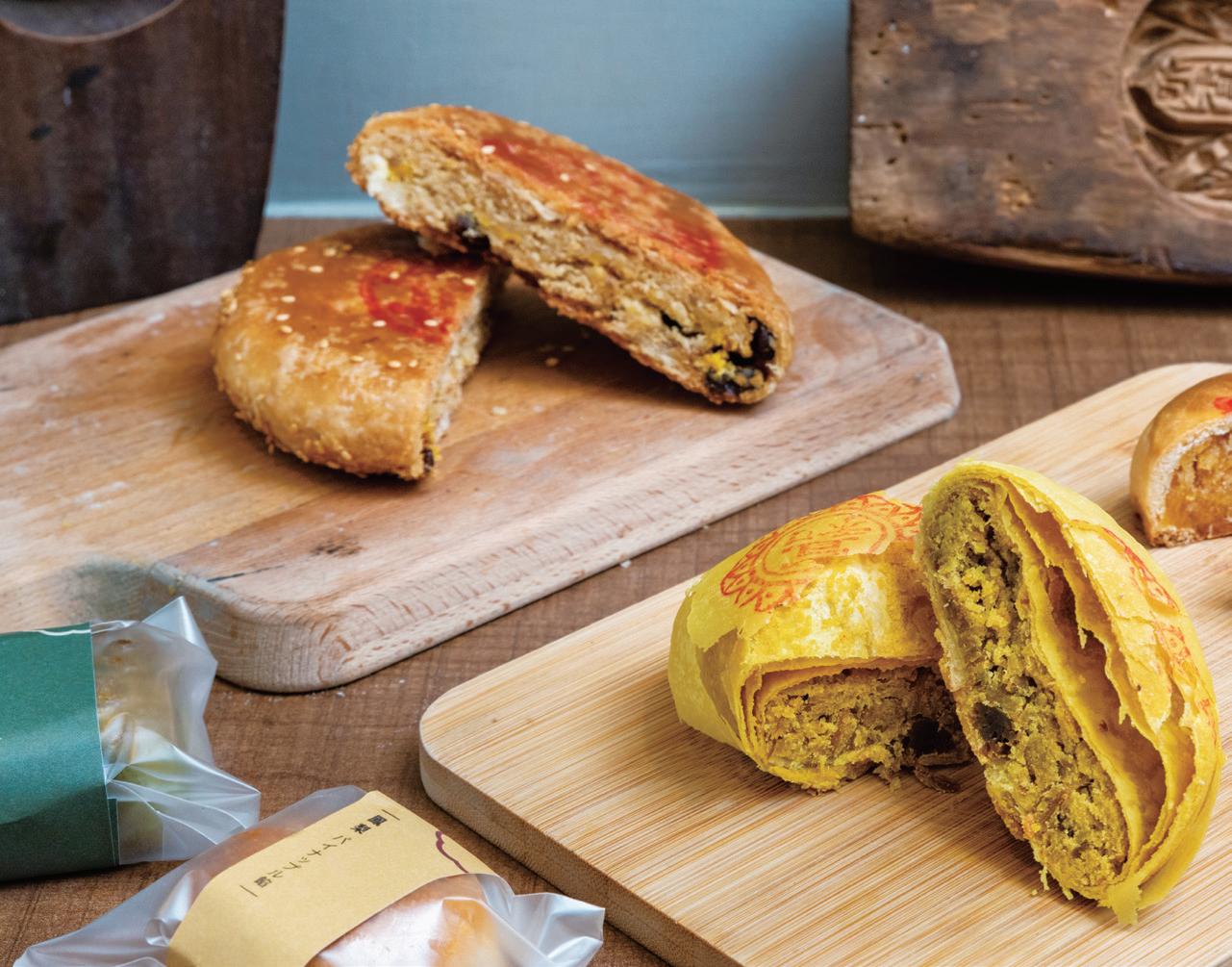
Ask any sweet-toothed visitor to Taiwan about local traditional-style pastries and they will surely rhapsodize about pineapple cakes. These crumbling-crusted jammy treats are undeniably good, but they are just the tip of the sugar-infused iceberg. Delve a little deeper and you will discover a whole industry catering to confection cravings built on families of bakers that have honed their craft over generations.
Throughout the Sinosphere, there is a strong tradition of baked treats made to be shared at times of celebration. These are pastries with symbolic wishes for good health or fortune baked into their very essence, and an ingredients list as evocative as a waft of sugar-scented air rushing out of a just-opened oven. Feeling peckish? Then dig in.
TEXT AMI BARNES PHOTOS RAY CHANG, VISIONNOT JUST SWEET
Surprising to Western palates, many traditional cakes and pastries in Taiwan are savory, not sweet





To find Years Cake, just follow the enticing aroma of baking down Taipei City’s Chaozhou Street until you spot the distinctive red-andblack store frontage. This establishment, now under the stewardship of third-generation owners, has been serving up freshly baked goods since 1950. In the early years, the store made its name selling cakes that were intended to be given and consumed at moments of ritual significance –weddings, funerals, and those days when the gods need to be honored with something sweet and special.

Wedding cakes in particular were this store’s bread and butter. In traditional Chinese culture, couples announce their upcoming nuptials by offering pastries to friends and relatives. Old-style wedding cakes were usually flat, round, large enough for a whole family, and filled with high-quality ingredients – sweetened beans, nuts, braised meat, or dried shrimp. This tradition is still widely practiced in Taiwan, although preferences have changed dramatically since the 1950s. Rather than taking aim at the perpetually moving goalposts of whatever flavor is currently in fashion, Years Cake has stood firm – its walnut and datepaste wedding cakes have earned the company loyal supporters.
Over time, plenty of new products have been added to the store’s repertoire, but the flavors remain decidedly towards the more traditional end of the spectrum. Offerings include pastries packed with mung beans, curry braised pork, salted egg yolk, taro, and sesame. Those curious to dip their toes in the world of simultaneously sweet and savory fillings don’t need to worry about biting off more than they can chew, since Years Cake sells most of its confections in small, medium, and large sizes. A good place to start is the store’s signature egg yolk and sesame cake – a circular wheel of flaky, melt-in-the-mouth pastry encasing a salted egg yolk and sesame paste filling.
YEARS CAKE ( 宜德和志 ) (02) 2394-9889
No. 149, Chaozhou St., Da'an District, Taipei City ( 台北市大安區潮州街 149 號 ) 10am~9pm www.0223218374.com (Chinese) www.facebook.com/yearscake
No. 309, Sec. 1, Dihua St., Datong District, Taipei City ( 台北市大同區迪化街一段 309 號 ) 10am~7pm



lee-cake.com (Chinese) www.facebook.com/leecake1895
Founded in 1895 by an immigrant from China’s Fujian Province, Li Ting Xiang specializes in classic sweet treats. Over the five generations that this family store has been in operation, the proprietors have worked hard to match their customers as preferences have shifted towards having smaller-sized selections in a greater variety of flavors, and with dialed-back sugar levels too.

The store’s current top seller is turtle cakes in irresistibly dainty individual portions. Variations on this cake can be found throughout East Asia, and like many traditional sweets, they come loaded with auspicious symbolism. Li Ting Xiang’s twist on the turtle cake is to replace the outer “skin” (usually made of glutinous-rice flour) with a mix of peanut flour and maltose. It offers two filling choices: sesame paste and nougat, both of which balance perfectly with the peanuty casing. Other popular items include several sweet and savory ping xi cake (a type of bun-shaped pastry), crumbly sesame-oil-infused mung bean cakes formed with delicate floral molds, and cinnamon rolls sprinkled with crisp flakes of Taiwanese sugar cookies for an added local flair.

As well as modifying its menu to match contemporary tastes, Li Ting Xiang aspires to change the way these snacks are enjoyed. Traditionally, customers would take their purchase home to share with family, but now visitors can enjoy “Taiwanese afternoon tea” in the store’s bright and airy premises at the northern end of Dihua Street, one of the city’s key heritage-architecture streets.
Before the global pandemic took root, the store even offered DIY sessions during which aspiring pastry chefs could make their own cakes. The classes were paused due to hygiene considerations, but there’s talk that they could start up again sometime soon. Until then, you can either head to the store to enjoy a drink and a treat, or else visit the Li Ting Xiang website to order pre-mixed dough and filling sets that can be cooked up in your own home.
 LI TING XIANG ( 李亭香 ) (02) 2557-8716#10
Turtle cakes are Li Ting Xiang's top sellers
LI TING XIANG ( 李亭香 ) (02) 2557-8716#10
Turtle cakes are Li Ting Xiang's top sellers
Lin’s Wagashi operates out of a corner building on Dihua Street, and unlike the other businesses included on these pages, it draws inspiration from Japanese confectionary culture. Founded in 1953, it was originally just a grocery store selling daily essentials and a few baked goods, but then the second-generation owner developed a passion for crafting Japanese sweets (known as wagashi). After visiting Japan to learn more about creating these delicacies, this Lin-family member returned and set about reinventing the family business. He focused on turning out small batches of preservativefree delicacies made using almost exclusively locally-sourced ingredients – a business model the store employs to this day.
The shop’s exterior is all red brick and decorative stucco moldings, while inside the walls are adorned with wooden cake molds. Shoppers jostle around a central table laden with individually wrapped sweets. Among them are miniature baked buns filled with chestnut, glistening cubes of squishy yokan, chewy brown-sugar mochi coated with a fine dusting of soybean powder, and of course that most popular of Japanese sweets, dorayaki. Items can be purchased individually or in gift sets, but remember to bring a credit card (Lin’s Wagashi is a cash-free store).
In winter, the store’s hottest item is the seasonal strawberry daifuku. Available only during the brief strawberry harvest, plump strawberries are bundled first in a layer of anko (sweet adzuki-bean paste), then a second layer of mochi. The resulting combination is a study in nuance – each component bringing its own specific soft texture and sweetness.
The store also offers an NT$50 set comprised of a cup of black tea and a monaka – crispy rice-flour wafers sandwiching a sweet spoonful of anko. It’s a perfectly balanced sweet pick-me-up that can be enjoyed on the spot.



LIN'S
0933-727-553
No. 247, Sec. 1, Dihua St., Datong District, Taipei City ( 台北市大同區迪化街一段 247 號 )

9am~6pm
www.wagashi.com.tw (Chinese)
 WAGASHI ( 滋養和菓子 )
Lin's Wagashi
Dorayaki
WAGASHI ( 滋養和菓子 )
Lin's Wagashi
Dorayaki
In the 1920s, a chef known as Master A-Hsiang took up a job in a small Tainan pastry store. After mastering the craft, he parted ways with his employers and moved to Kaohsiung to open a shop of his own. He called it Zhen Nan Pastry Shop (the “Jiu” part of the name – meaning “old” – didn’t arrive for another couple of decades).

Jiu Zhen Nan has a range of year-round offerings encompassing staples of the Taiwanese pastry scene, such as pineapple cakes, nougat, nut brittles, and mung-bean cakes. But where this company excels is its selection of exquisitely presented treats for special occasions. You can order salted egg yolk mooncakes in the run-up to the Mid-Autumn Festival or iced “crystal” rice dumplings for the Dragon Boat Festival. Jiu Zhen Nan even sells a baked version of the traditional sansheng offerings (pork belly, a whole fish, and a whole chicken) that adorn altars during the Chinese New Year period.
At the company’s Regent Galleria Store in Taipei, customers can have a go at making some of these pastries with their own hands. After all, taking home a box of pineapple cakes is great, but returning home with the ability to make your own pineapple cakes is infinitely better.
JIU ZHEN NAN (REGENT GALLERIA STORE) (

舊振南晶華店 )
(02) 2511-2295
No. 3, Lane 39, Sec. 2, Zhongshan N. Rd., Zhongshan District, Taipei City (1F of Regent Taipei) ( 台北市中山區中山北路二段 39 巷 3 號 )( 晶華酒店 1F)
www.jzn.com.tw
www.facebook.com/jiuzhennan
Arriving on the scene in 2008, SunnyHills is a young upstart in this industry full of baking dynasties, but that’s no reason to underestimate the operation. The company’s signature pineapple cake is a textbook example of doing one thing and doing it to perfection. Indeed, for the first few years, it was the only item it sold – a bold business move, especially when considering the stiff competition faced.
To set itself apart, SunnyHills intentionally focused on becoming a purveyor of premium pastries. Every detail has been carefully chosen to underscore this impression of being a top-class establishment, from the unhurried in-store customer experience to the unorthodox jam recipe (SunnyHills insists on using just one specific pineapple cultivar, the Nantou County-grown Cayenne No. 2, and does not pad the filling with cheaper ingredients like wax gourd, as is now commonly done elsewhere). This considered approach has garnered it a devoted following.
With its reputation now firmly established, the company has branched out into offering several other products, including multiple variations of their signature pastry-cased ingots using different seasonal fruits such as apple, strawberry, and pomelo.


Pineapple cake aficionados can pick up a box or two (or three) from SunnyHills’ Taipei branch on Songshan District’s Minsheng East Road, but don’t worry if you find yourself running short on time – since 2015, SunnyHills has also had a store in Taoyuan International Airport for all those emergency pastry purchases.
SUNNYHILLS (MINSHENG BRANCH) ( 微熱山丘 台北民生公園 )
(02) 2760-0508
No. 1, Alley 4, Lane 36, Sec. 5, Minsheng E. Rd., Songshan District, Taipei City ( 台北市松山區民生東路五段 36 巷 4 弄 1 號 )
10am~6pm www.sunnyhills.com.tw (Chinese)

Located just a minute’s walk away from Exit 6 of MRT Ximen Station, Tai-ho Traditional Biscuit has been selling its sweet snacks for three generations. The store was opened in the late 1940s by the Chen family, who, like the founders of Li Ting Xiang, had also left China’s Fujian Province to start a new life in Taiwan. With them, the Chens brought recipes for their hometown favorites – sweetly sticky-centered laopo “wife” cakes, crisp and chewy bars of sachima, seed-flecked Mazu biscuits – all of which can still be found filling their store shelves. The recipes have been changed a little over time, incorporating smaller quantities of sugar and oil, but the cakes are still hand-made.
TAI-HO TRADITIONAL BISCUIT ( 太和傳統餅 )
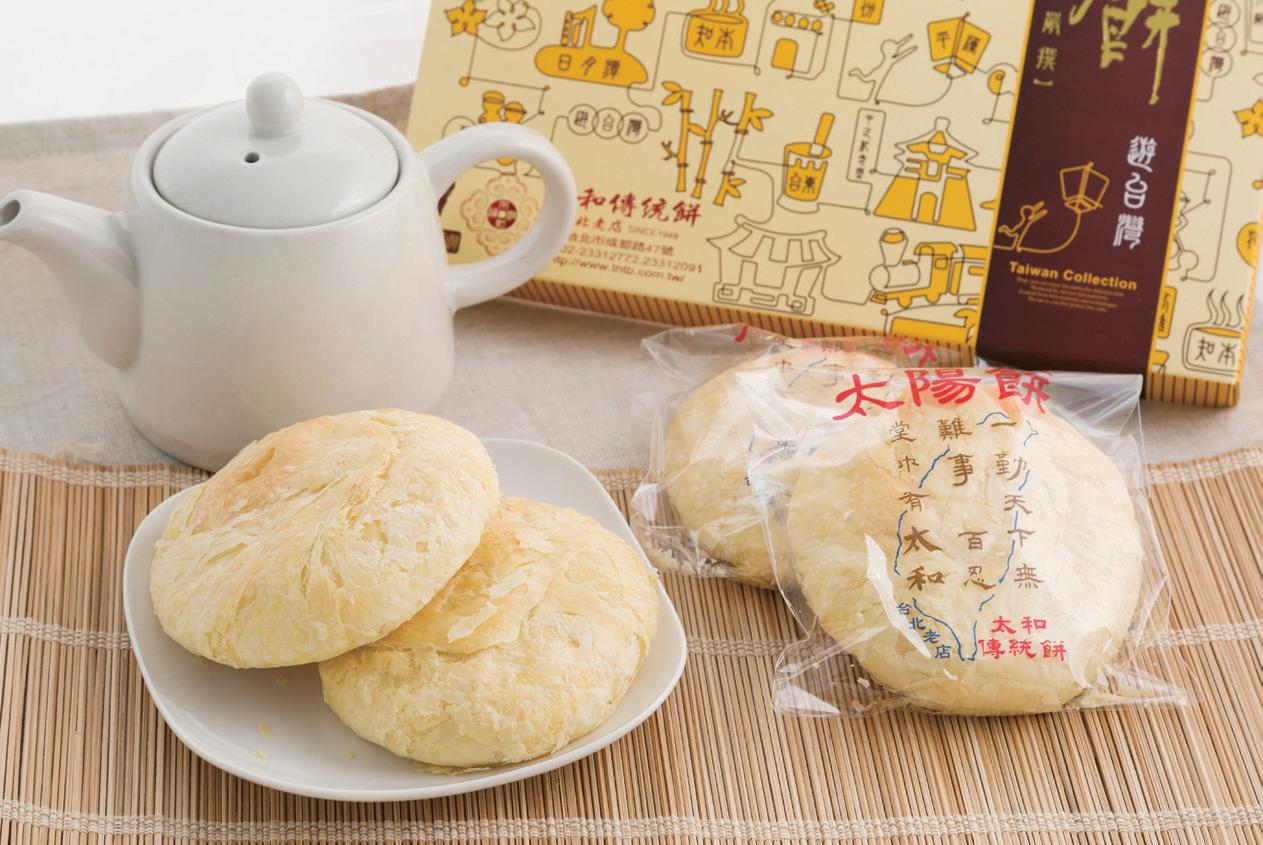
(02) 2331-2772
No. 47, Chengdu Rd., Wanhua District, Taipei City ( 台北市萬華區成都路 47 號 )
10am~7pm
www.thtb.com.tw (Chinese)

www.facebook.com/taihotw
SUN CAKES
Sun cakes, which originated in Taichung City, are a staple among traditional Taiwanese pastry shops; they are still hand-made at Taiho, but with less sugar and oil than in the past
The store has won a place on many tourist itineraries, thanks in no small part to its pineapple cakes and nougat formed in the shape of Taiwan. Kitsch these may be, but if you want to take home a souvenir that screams “I’ve been to Taiwan,” these will certainly get the point across. For something a little more subtle, Tai-ho also sells many varieties of easily transportable baked goodies in packs meant for sharing. And regardless of what you pick, you’re bound to make friends if you return home bearing sweet treats.
ENGLISH AND CHINESE
Chaozhou Street 潮州街
Dihua Street 迪化街 laopo cake 老婆餅
Master A-Hsiang 阿祥師
Mazu biscuits 媽祖餅 ping xi cake 平西餅 sachima 薩其瑪
sansheng 三牲
Zhen Nan Pastry Shop 振南製餅舖
Part of visiting a foreign land is exploring its culinary offerings. For some travelers it can’t get exotic enough, and Taiwan certainly has its fair share of unusual snack food options. But don’t be fooled by some of the strange names you might see at night-market stands and on restaurant menus. The food is sometimes not exactly what the name might lead you to believe.
This is a well-known savory treat from Tainan City in south Taiwan. It was created in the 1950s by a restaurant owner surnamed Xu, who was asked by friends to create a Western-Eastern combo snack. He came up with what he called “Chicken Liver Plank,” a deep-fried thick toast, hollowed out and filled up with chicken liver and other morsels, with a thin layer of toast on top. Looking at the box-like shape, the delighted friends gave it a different name, “Coffin Bread” – the name that would stick. This treat is widely sold today, the filling usually a mix of roasted flour, stock, milk, onion, chicken, and octopus.
While Tainan in the south is known for its Coffin Bread, Keelung City in the far north has its own Western-influenced snack food treat, the Nutritious Sandwich. Its name is somewhat double-misleading: first, unlike a Western sandwich, the bread has an oblong shape and is deep-fried; second, while the treat is rich in calories, the nutritional value is not especially impressive. The sandwich – filled with ham, soy-braised egg, cucumber, and tomato – was created in an attempt to satisfy American soldiers on R&R in Taiwan during the Korean and Vietnam wars who landed at the port of Keelung and were craving food from their homeland.
This is the name of a small restaurant in Changhua City, established over a century ago, and also the name of one of the main dishes on its menu. Do they serve cat and mouse meat? Of course not! The restaurant was named after the son of the restaurant’s first-generation proprietor. He was a small but nimble boy, which earned him the nickname “Little Mouse.” Father and son also happened to be born in the Year of the Mouse. The restaurant’s name contains the Chinese characters for cat and mouse because of the way “mouse” is pronounced in the Minnan dialect. Coincidently, the Mandarin pronunciation of the combined characters for cat and mouse, maoshu , is also pretty close to the pronunciation of the English word “mouse.” The Cat Mouse Noodles on the menu is a simple noodle soup with a shrimp ball, a mushroom meatball, and a chicken roll.
Fly Heads is a simple stir-fried dish that, rest assured, contains no flying-insect bits. The dish was created by the chef at Wang Cheng Laoma, a restaurant in Taipei serving Sichuan cuisine. Not wanting to discard unused garlic chives, the chef came up with this idea: chop up the chives, mix them with ground pork and black beans, and add copious amounts of garlic, like a Sichuan chef would do. Originally meant as a simple dish to be enjoyed with white rice by his staff, the dish was received so well that it soon made it onto the menu, to become one of the must-order dishes at the restaurant. The “fly heads” are of course the black beans in the dish.
ENGLISH AND CHINESE Cat Mouse Noodles 貓鼠麵 Coffin Bread 棺材板 Chicken Liver Plank 雞肝板With close to eighty percent of Taiwan’s population living in urban areas, visiting leisure farms has become a popular way to relax. Agritourism enterprises offering all sorts of hands-on experiences have proliferated, and Yilan County, with its verdant fields and dramatic mountainous backdrop, is the ideal place to roll your sleeves up and get stuck in.
From the air, Yilan County’s coastal Zhuangwei Township is a latticework of neatly-parceled-up portions of land. Green paddy fields and strips left fallow are interspersed with fish farms – the surface of their waters looking almost black save for white splodges indicating the presence of wheel aerators. Occupying a couple of reclaimed fishponds in the midst of this fragmentary landscape sits Niutousi Farm.
This small-scale operation was opened six years ago by Shen Guo-yuan and his uncle Huang He-cheng to preserve and share Taiwan’s farming traditions. As a teen, Huang was briefly involved in the cattle-trading industry. “He’d already left it for a long time,” clarifies Shen, “then one year, at the Yilan Green Expo, someone asked him to help lead some cattle.” The experience prompted a cherished flashback. “It reminded him of the work he used to do with my granddad, and that’s when he asked me if I’d like to open the farm with him.”
However, they had a problem. “Of course, I’d grown up seeing cattle, but I knew nothing about them,” Shen admits somewhat sheepishly. Undeterred, he hit the books, and it was during the course of his research that he stumbled upon the name “Niutousi.”
When the Dutch East India Company arrived on Taiwan’s shores in the 1600s, it saw potential in the western
plains’ fertile farmland. Earlier settlers from China had brought water buffalo, but their stocky, muscular frames were more suited to turning the soil of waterlogged paddies and the Dutch needed a draft animal that could be used to till dry fields. So hard-working yellow cattle were imported.
During this period, yellow cattle and their water buffalo brethren were such a valuable resource that a governing body was formed to oversee their management and educate the public on matters related to cattle keeping. The name of that organization in Chinese was Niutousi, literally “cattle head directorate.”
In the centuries following, at the height of Taiwan’s dependence on the creatures it could be said that each rural household had one plot of land along with one head of cattle, and farmers’ livelihoods were inextricably intertwined with
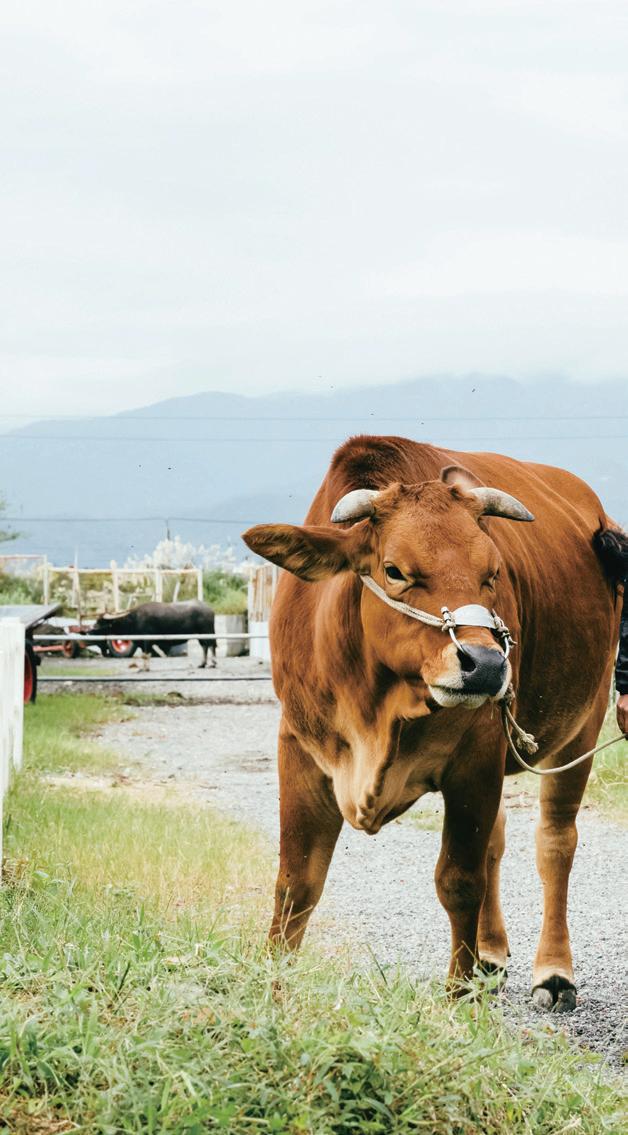
Feeding the friendly cattle at Niutousi is part of having fun at the farm


the lives of their bovine helpers. A lingering reminder of this tight bond can be seen in the still large (although dwindling) portion of Taiwan’s society which eschews beef.


At Niutousi, the animals are, rightfully, the stars of the show, and Shen could happily tell you the life story and personality of every single one. “Ah, this is Xiao Bai,” he says enthusiastically, pointing at an elegant, cream-hided beast. “She’s a celebrity cow from the oyster farms in Fangyuan Township (on the west coast; cattle are used to pull old-style carts around the tidal-zone farms).” Xiao Bai (“Little White”) arrived at Niutousi after she grew too old to perform her regular duties. Others have arrived via cattle traders, having been purchased from owners who were no longer able to work the land. Traders usually keep such cattle on their books for up to a year, but any that fail to sell will be shipped off to the slaughterhouse. Bong-tshi (a name sounding like a Taiwanese expression for raising an undesired female child), a placid and pretty water buffalo, just narrowly escaped this fate, and the farm’s champion worker, Niu Wang (“Cow King”), also came from a trader. “She broke one of our plows,” Shen says when talking about Niu Wang. “She’s so strong! We tied three tires onto the yoke in an attempt to slow her down, but she could still run, even then!”
The pride and affection Shen feels for his charges is evident, and the cattle that arrive at Niutousi have certainly found their place in the sun. The farm will not sell them on, so each can expect to live out the rest of its days enjoying a steady supply of food and adoration.
Farmer Shen Guo-yuan with one of his prized cowsIn my admittedly not extensive experience with cattle, eating and getting back scratches seem to be two of their favorite pastimes. Luckily for the cows (and one bull) who call Niutousi home, these are two things that are not in short supply. For the price of admission, guests can enjoy giving the animals a good back rub and hand-feeding them fistfuls of grass. With each of the cattle consuming approximately 50kg of grass each day, no matter how many visitors pass through, they are perpetually enthusiastic participants in this activity.
Naturally, what goes in must come out, and those 50kg of grass results in a whole lot of dung. Not wanting to waste this valuable resource, Niutousi Farm sees it as an opportunity to educate visitors about circular models of agriculture. “This is a really beautiful one,” says Shen, grinning and proffering up a perfectly conical heap of dried dung that’s been preserved for demonstration purposes. It may seem like a strange thing to get excited about, but dung has many practical applications. It can be used as a building material, a fertilizer, or a fire source – and farm guests who pay a little extra can get personal experience of the latter two by mixing their own potting compost for a succulent and by cooking popcorn over a fire made with dried dung chips (just remember to wash your hands before you tuck in).
But for me, the highlight of the visit was being able to have a go at plowing the old-fashioned way. As I swapped my shoes for a pair provided by the farm, Shen fetched one of the buffaloes from its enclosure. He returned with Niu Wang in tow and, apprehensively, I recalled his earlier description of her seemingly unstoppable pulling power. Shen then walked a couple of rows to show me how it’s done before inviting me to take hold of the plow. Stepping into the furrow, I sank up to my calves in thick, cold mud, and with a light flick of the rope, we were off. The first minute was spent simply focusing on walking and not giving myself an accidental mud facial, then it was time to attempt some actual plowing. Despite Niu Wang’s valiant leadership and plenty of unearned praise from Shen, I did little more than stir up the muddy water. After a couple more back-and-forths, I gave up, mud-spattered and tired, but exhilarated.


The following day I awoke to aching muscles and a few flecks of errant mud – the very best kinds of souvenirs!
STUCK IN MUD
Plow the fields and use cow dung to make popcorn
NIUTOUSI FARM ( 牛頭司 (03) 930-7707 No. 21, Lane 122, Sec. 1, Dafu Rd., Zhuangwei Township, Yilan County ( 宜蘭縣壯圍鄉大福路一段 www.facebook.com/calfstirk2018
ENGLISH AND CHINESE Bong-tshi 罔飼
Fangyuan Township
Huang He-cheng 黃和誠
Shen Guo-yuan 沈國源
Yilan Green Expo 宜蘭綠色博覽會
Zhuangwei Township
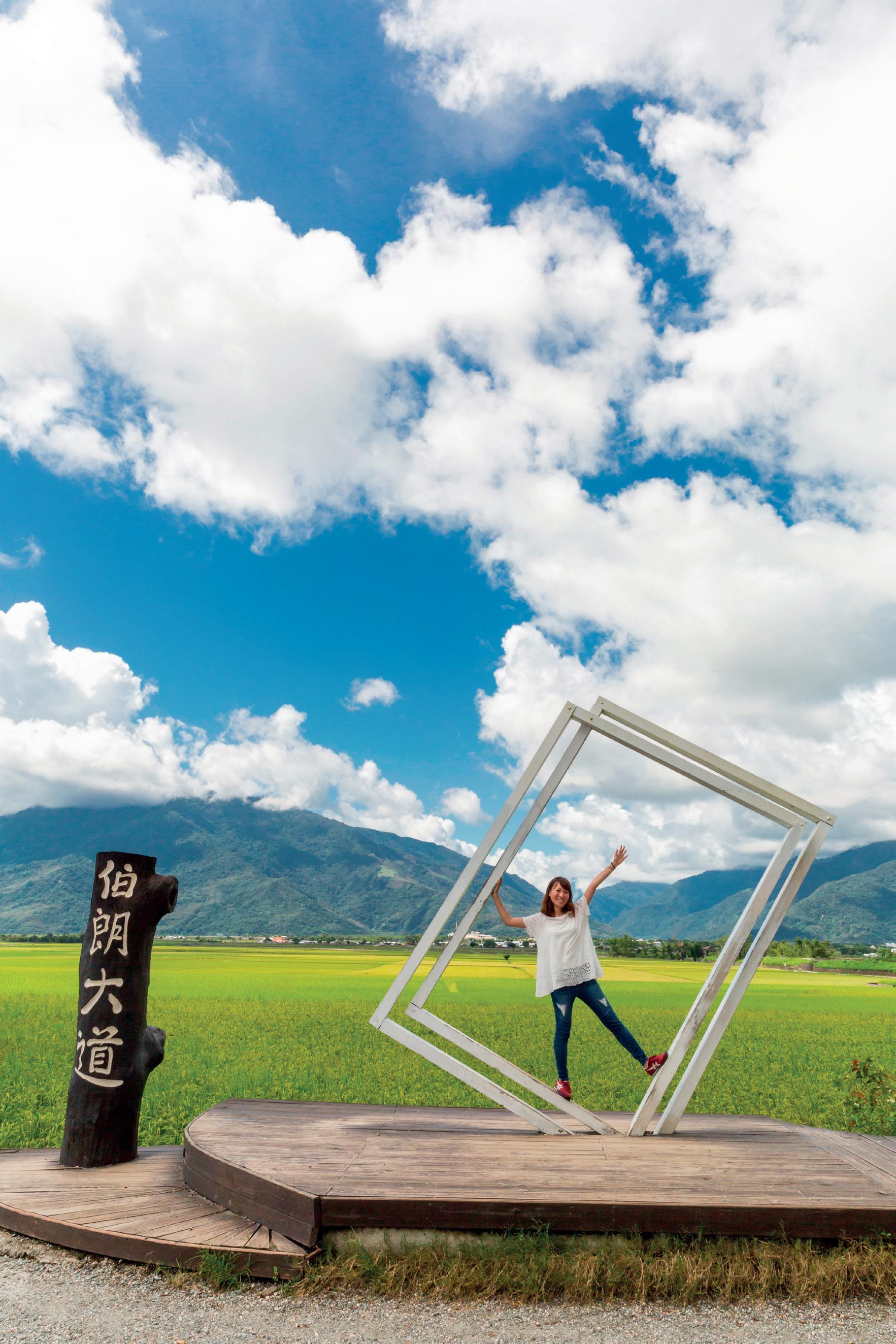
EVERYTHING YOU NEED TO KNOW ABOUT TRAVELING IN TAIWAN!
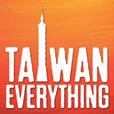

Find Travel in Taiwan articles published in earlier issues, complemented with colorful images, Google maps, and links to our social media sites, including Youtube, Facebook, and Instagram, and informative sites of other bloggers in Taiwan.














Taipei City HOTEL
Situated on Mt. Jiantan in Taipei, the Grand Hotel is a 14-story palace-style building constructed in 1970. There are two underground tunnels, under its east wing and west wing, respectively, which were designed as emergency escape routes for President Chiang Kai-shek. After opening the West Secret Tunnel earlier, receiving enthusiastic response by visitors, now, the 50-year-old East Secret Tunnel has been opened to the public as well. It has a length of 67 meters with a curvy design meant to prevent chasing soldiers from shooting at the fleeing parties, and walls with an uneven surface to enhance sound absorption. Since only a limited number of visitors can be accommodated, the East Secret Tunnel is only open to guests who come on corporate trips, attend state banquets, or opt for a special East Secret Tunnel Room Package.
No. 1, Sec. 4, Zhongshan N. Rd., Zhongshan District, Taipei City ( 台北市中山區中山北路四段一號)
Tel: (02) 2886-1818 ext. 1818 [guided-tour department] www.grand-hotel.org
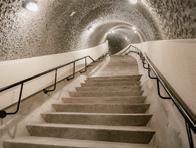
Taipei City HOTEL
Renaissance Taipei Shihlin Hotel, which is located near Chiang Kai-shek Shilin Residence Park, is now promoting a special Executive Floor room offer. From now until March 31 a room for two on the 8th to 10th floors of the hotel is available at NT$6,199 per night (Sunday through Friday; an additional NT$800 is charged on Saturday and national holidays). The offer includes a buffet breakfast for two and a Happy Hour discount for two at the Executive Lounge. From the outdoor infinity pool on the top floor of the hotel you can enjoy views of the city and its natural environment, including the mountains of Yangmingshan National Park and the Taipei Performing Arts Center.
No. 8, Lane 470, Sec. 5, Zhongshan N. Rd., Shilin District, Taipei City (台北市士林區中山北路五段470巷8號)
Tel: (02) 8861-2389 www.gobooking.com.tw/Renaissance/ShihlinTaipei
This season, Va Kang An Hot Spring Park Park presents the "Red Leaf Valley Asteroid 121 Set Meal." Diners can learn about indigenous Bunun culture through delicious local cuisine. Also available is a package that includes staying at the "Bishalu" guesthouse and an admission ticket to the park. Staying in one of the guestrooms that are decorated with driftwood art and elements of Bunun culture you will feel the passion of the homestay owner. Each weekend, you can also take part in six different localtheme activities. You are cordially invited to rediscover the splendor of the Red Leaf Hot Spring area. Taste a glass of tribal-style cocktail during your time in the valley and also visit the Red Leaf Little League Memorial Hall to complete your indigenous-culture tour.
No. 121, Honggu Rd., Yanping Township, Taitung County (台東縣延平鄉紅谷路121號)
Tel: (08) 956-1068 www.vakangan.com (Chinese)







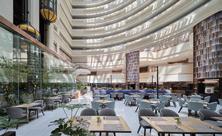
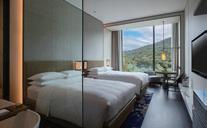
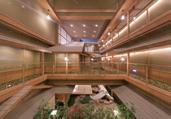
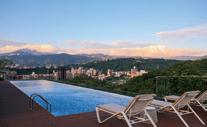
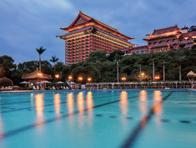

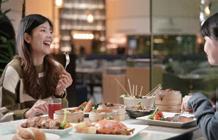
No. of rooms: 257


Room rates: City View Rooms from NT$7,800; Japanese/ Western Rooms from NT$16,800
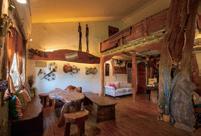
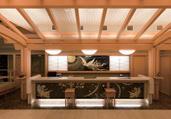
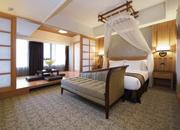
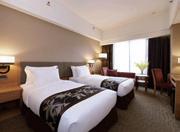
(room rates are subject to 10% service charge)
Desk personnel speak: Chinese, English Restaurants: Happy Garden (Chinese, Cantonese), Arcadia Café (Western style)
The hotel is located close to Hualien Harbor, allowing you to enjoy the most beautiful sunrise over the Pacific Ocean, the water’s color ranging from deep azure to light blue, the sun’s palette ranging from pale yellow to golden. Take in the marvelous views of the sun beautifully reflected by the sparkling sea from the infinity pool or one of the sea-view guestrooms. Staying at the hotel gives you easy access to the world-class scenic wonder that is Taroko Gorge as well as the bucolic East Rift Valley. Travel with friends and family and explore the mountains and the coast. Hualien will surely give you unforgettable memories!
No. 51, Minsheng Rd., Hualien City, Hualien County (花蓮縣花蓮市民生路51號)
Tel: (03) 823-9988 Fax: (03) 823-0077 www.fullon-hotels.com.tw/hl/en/
Taipei City HOTEL
Radium Kagaya is located close to MRT Xinbeitou Station with numerous well-known spots close by. The hotel is perfectly located for exploring Beitou’s tourist attractions or visiting Yangmingshan National Park for the calla lily and hydrangea season (March to June). The building was constructed using Japanese architectural techniques; a total of 850 artworks from Ishikawa Prefecture in Japan, including Wajima lacquerware, Kutani ware, and gold leaf items, were incorporated in its design. In addition to enjoying a white-sulfur hot-spring bath and a Beitou stone bath inside the hotel, you can also opt for a greensulfur hot-spring bath in its annex. The spring water is extremely acidic and contains radium, which is especially effective in relieving soreness. After soaking in the hot-spring pools, enjoy fine banquet dishes made with Taiwanese and Japanese seasonal ingredients while marveling at the exquisite tableware.
No. 236, Guangming Rd., Beitou District, Taipei City (台北市北投區光明路236號)
Tel: (02) 2891-1238 www.kagaya.com.tw
Sunny Buffet, which is now managed by FDC International Hotels’ Collection, is known for its 16-story high glass ceiling, which fills the space with natural light. The restaurant also has numerous green plants giving it an outdoor ambience. This February, the cuisine has been upgraded significantly; there are now 17 buffet stations instead of the original nine. Among the new dishes are Thai-style red-curry crab, traditional Chongqing-style spicy skewers, and Mongolian barbecue. From Monday to Thursday (noon), each diner receives an extra serving of garlic-flavor abalone with butter vermicelli. Meals are priced NT$980 + 10% on weekdays and NT$1,180 + 10% on weekends and holidays.
Just Sleep Yilan Jiaoxi now presents a special room offer. If you stay at the hotel before March 31, you can visit Niutousi Farm to enjoy a fun water buffalo farm experience. Learn about traditional farming in Taiwan through close interaction with cattle. The offer includes a buffet breakfast and staying in a guestroom with a large private hot-spring pool. When booking a room on the official website you will also enjoy a 20%-discount on High Speed Rail tickets.
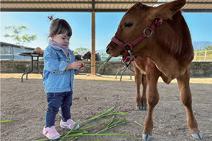
No. 8, Lane 24, Deyang Rd., Jiaoxi Township, Yilan County ( 宜蘭縣礁溪鄉德陽路24巷8號)
Tel: (02) 7735-5005 www.justsleephotels.com
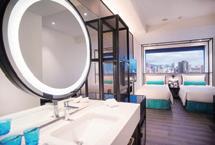
Thanks to its floor-to-ceiling windows Humble Boutique Hotel’s BeGood restaurant is filled with natural light. It also features a beach resort-style décor. The restaurant now offers a new brunch set menu starting at NT$1,180. It’s available on weekends from 11:30am to 3:30pm. Popular classic dishes such as Tiger Prawn Porridge and Three Cheese Flatbread have been specially added to the menu. The set menu includes a salad, a soup, a main dish, and a dessert or an energizing smoothie. This selection of Mediterranean-style creative dishes full of color and fresh flavors is perfect for a weekend full of energy and relaxation!
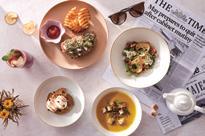
No. 116, Songjiang Rd., Songshan District, Taipei City (台北市中山區松江路116號)
Tel: (02) 2564-3577 humbleboutique.com.tw
Taipei City FOOD
The Shanghai restaurant is located inside Taipei 101, the most popular sightseeing spot in Taipei. Combining the advantages of different regional cuisines of China, refining taste and presentation, and not forgetting to preserve the classic flavors while continuously striving for innovation, we satisfy diners’ senses and present new culinary trends. In the dish "Legendary Braised Dong Po Pork with Tea" a classic thick red sauce is paired with a cup of fragrant and sweet Oriental Beauty Tea, creating a fresh and non-greasy taste. "Crab Roe Sauce on Toast" is a soy milk toast topped with a rich and delicious crab roe sauce. The dish is a must eat equally loved by old and young diners!
4F, No. 45, Shifu Rd., Xinyi District, Taipei City (台北市信義區市府路45號4樓)
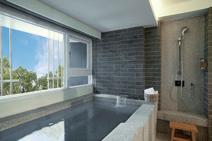
Tel: (02) 8101-8161
Hours: 11:30am ~ 2:30pm, 5:30pm~9:30pm www.facebook.com/THEShanghai101
Taipei City HOTEL
Taiwan’s well-known Caesar Park Hotels & Resorts chain has thoughtfully built the Caesar Metro Taipei hotel in Wanhua, a city district rich in culture and history, bringing new vitality to an old neighborhood. With its convenient location – sharing a building with TRA Wanhua Station and being close to MRT Longshan Temple Station – and having many historical and cultural sites close by, Caesar Metro Taipei is a top choice for travelers. With a total of 745 guestrooms, the hotel is the second largest in Taiwan. Exquisite double rooms are available for as low as NT$2,500 on weekdays; an additional NT$400 is charged on Friday and NT$800 on Saturday.
No. 167, Bangka Blvd., Wanhua District, Taipei City (台北市萬華區艋舺大道167號)
Tel: (02) 2306-6777 www.caesarmetro.com






Taipei City HOTEL

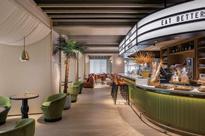
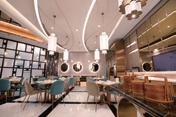
Le Méridien Taipei’s My Humble House Chinese restaurant has been included in the Michelin Guide for five consecutive years. Until March 31, the restaurant offers the "Golden Cantonese Duck Banquet," a set meal featuring duck prepared in four different ways. The meal is priced NT$3,980 per set, and reservations have to be made one day in advance. In addition, if you order this meal, you will also enjoy a special price of NT$99 for each additional Cantonese dim sum dish and dessert handmade by the restaurant’s dim sum team.
No. 38, Songren Rd., Xinyi District, Taipei City (台北市信義區松仁路38號)
Tel: (02) 6622-8018 www.lemeridien-taipei.com
From the stock to the ingredients to the spices, everything is carefully selected and strictly controlled.
In addition to Japanese style, hot and spicy, stone hot pot, and sukiyaki, there are also limited soup bases that are introduced according to the season.
Takao 1972 is the first restaurant to combine hot pot dining with Japanese cuisine.

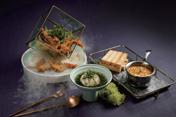

In addition to the hot-pot selections, the restaurant serves freshly made Japanese dishes, including black tuna sashimi, temaki, and sushi. Diners can enjoy richer and more diversified choices.
Midtown Branch (德立莊店)
Tel: (02) 2311-1577


Add: No. 110, Yanping S. Rd., Zhongzheng Dist., Taipei City (台北市中正區延平南路110號)
Kunming Branch (昆明店)
Tel: (02) 2331-3677
Add: No. 46, Kunming St., Wanhua Dist., Taipei City (台北市萬華區昆明街46號)
THE上海Taipei City HOTEL Taipei City FOOD

